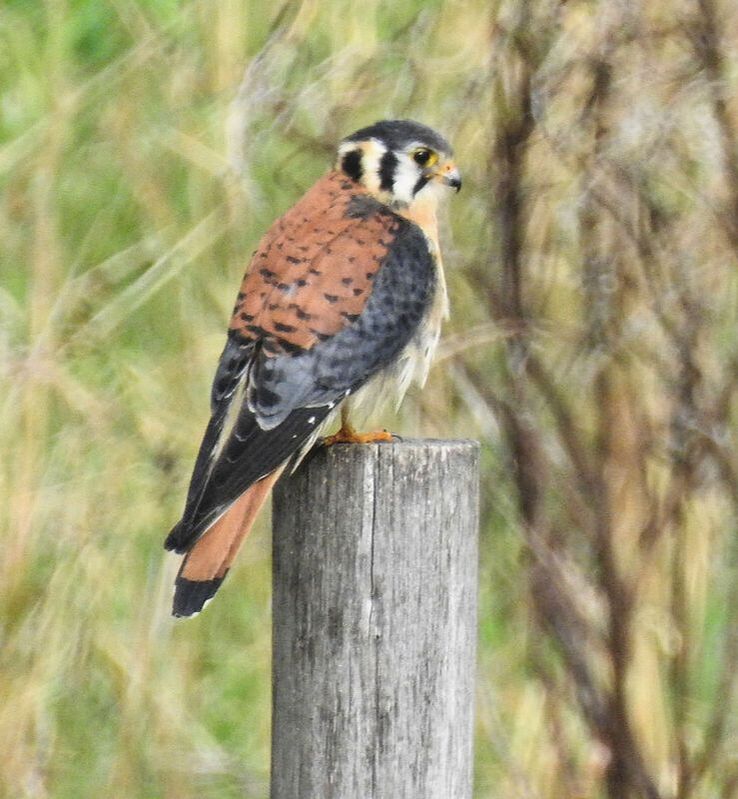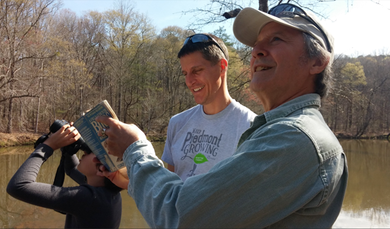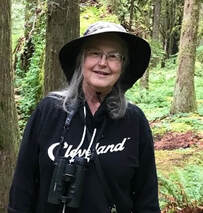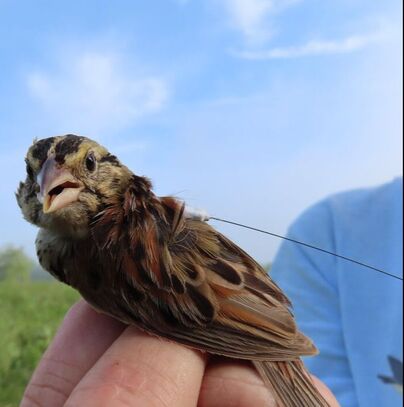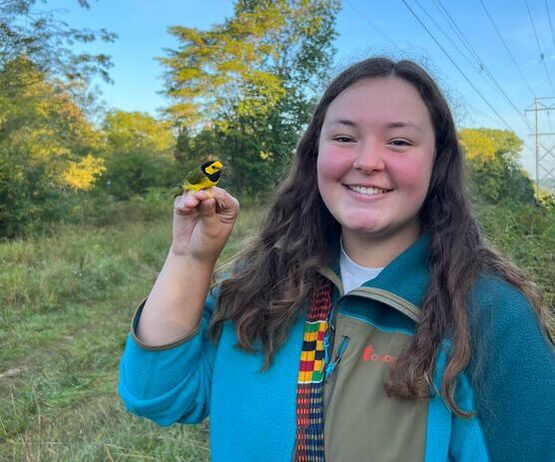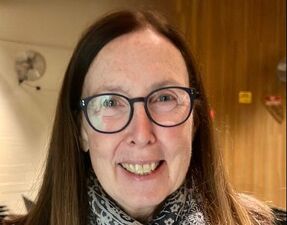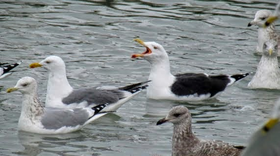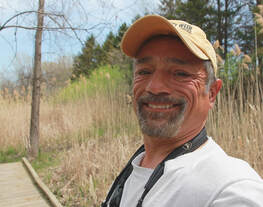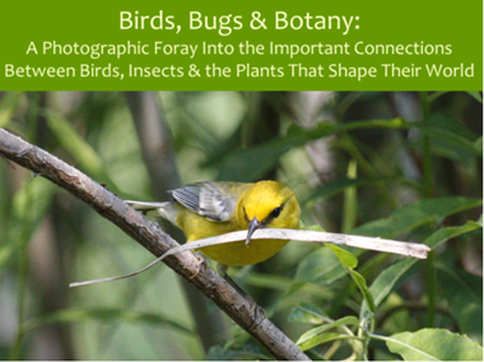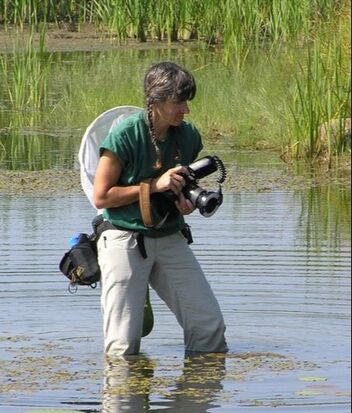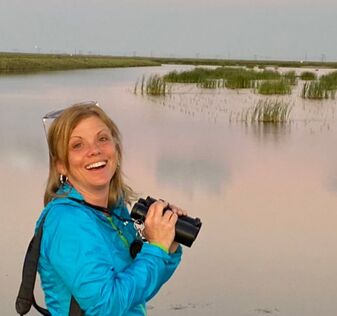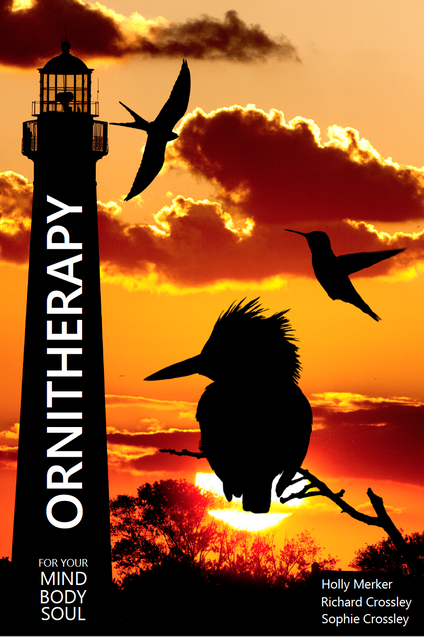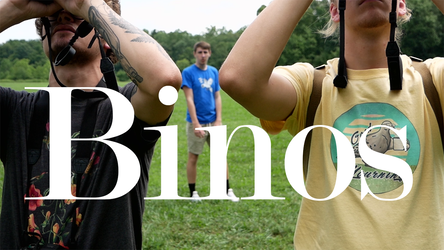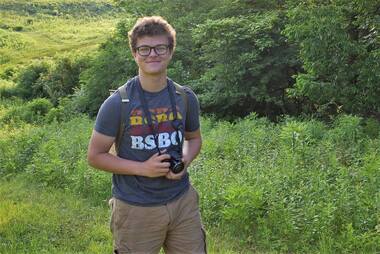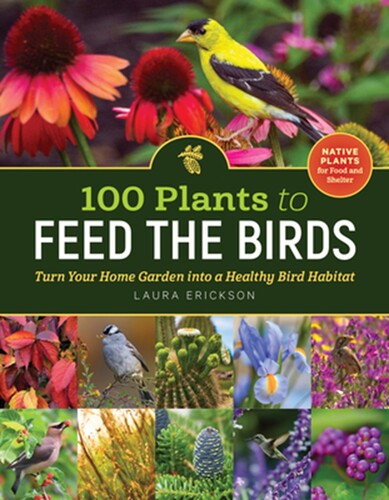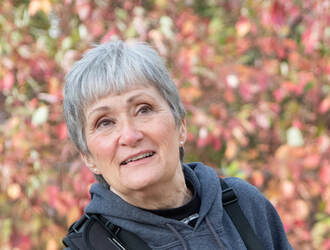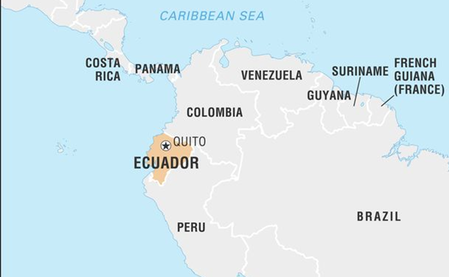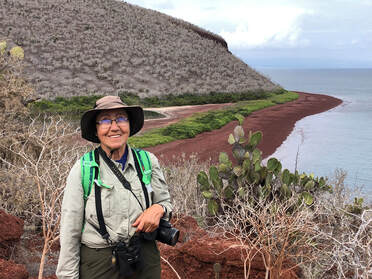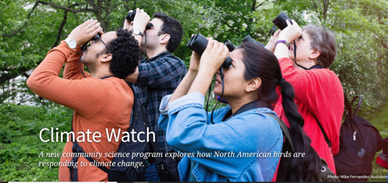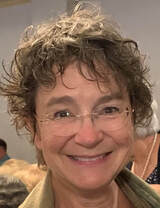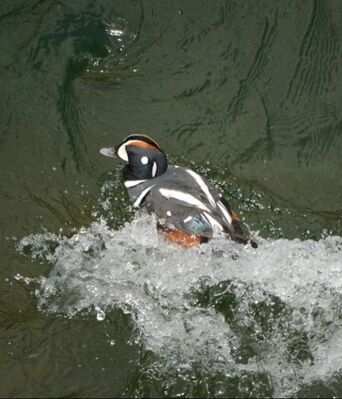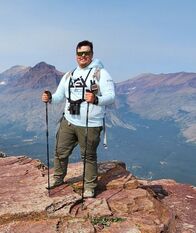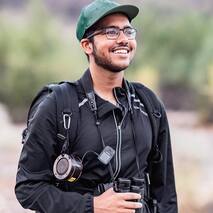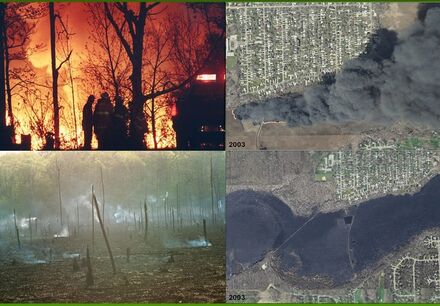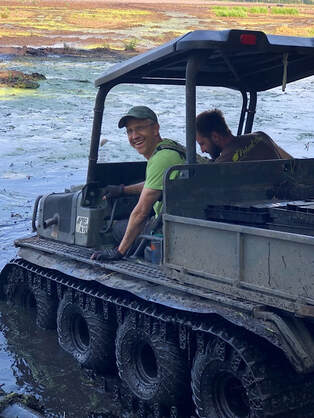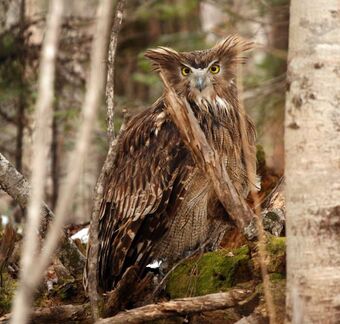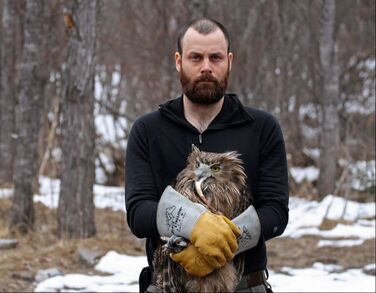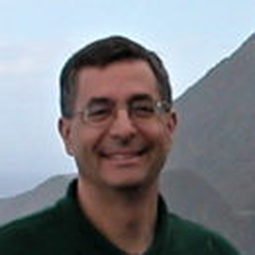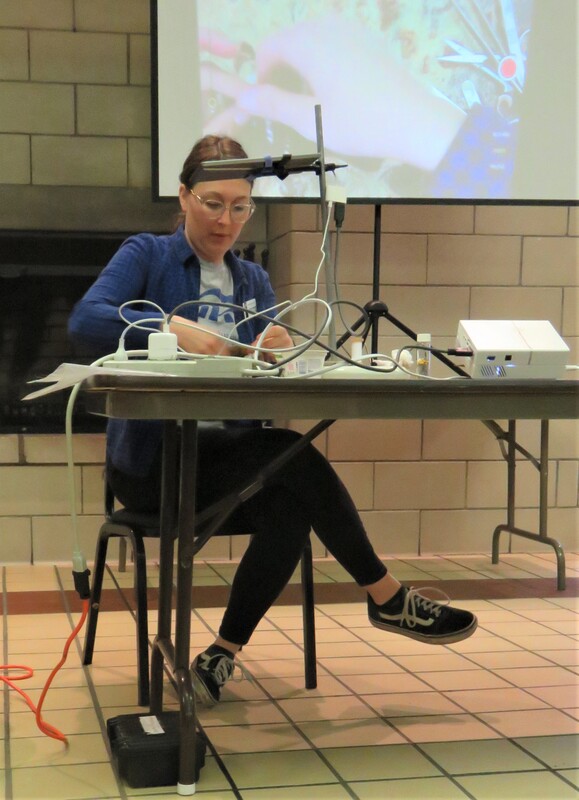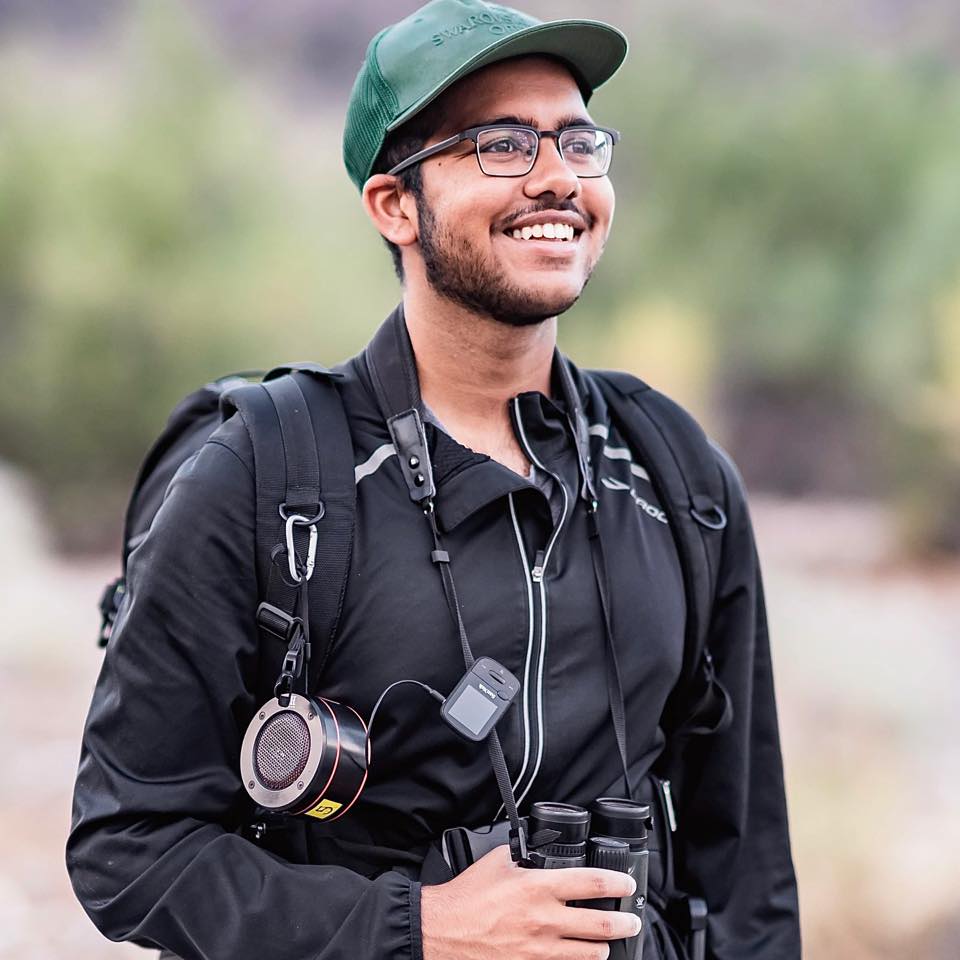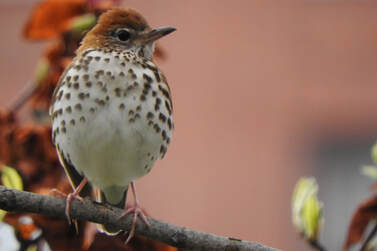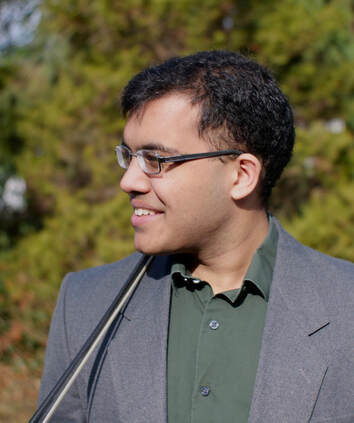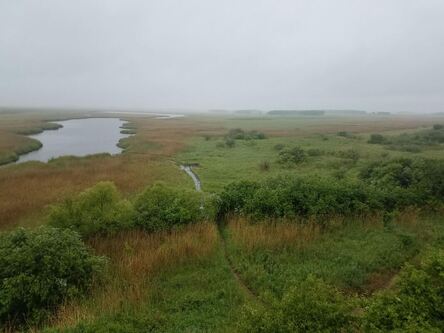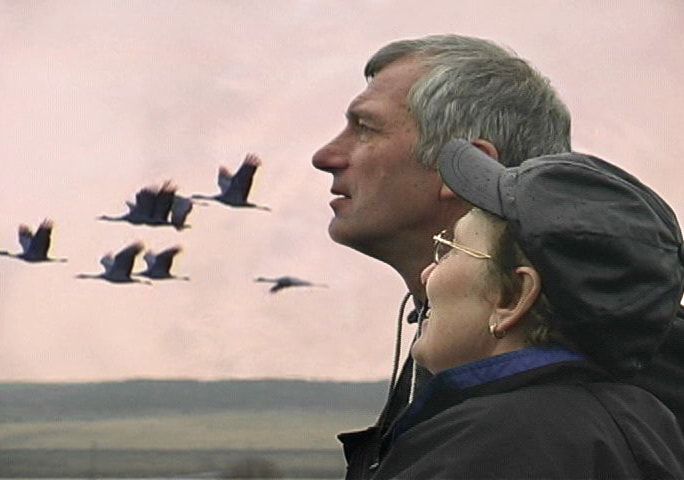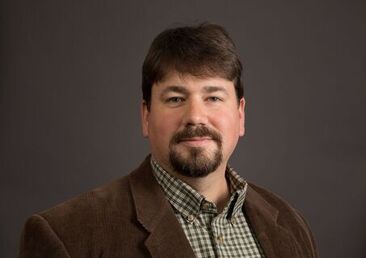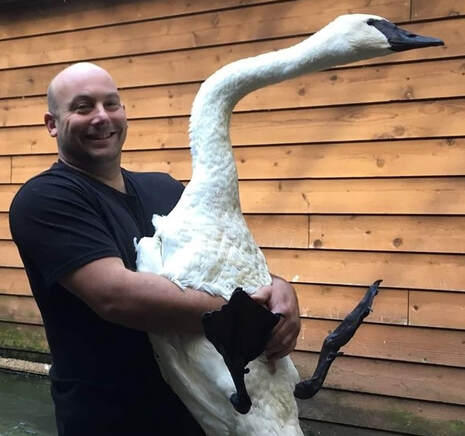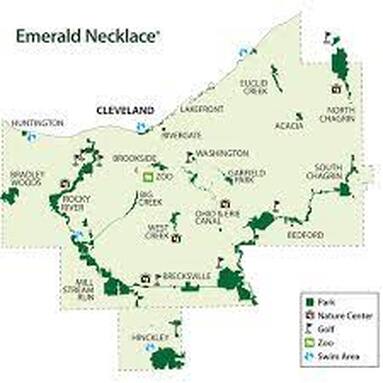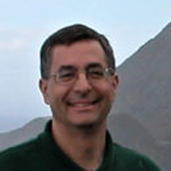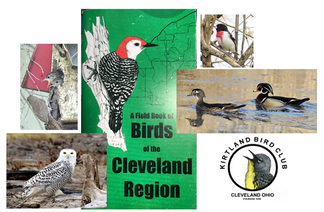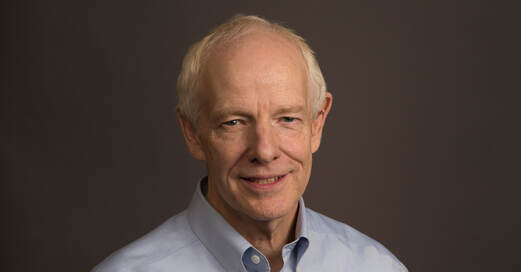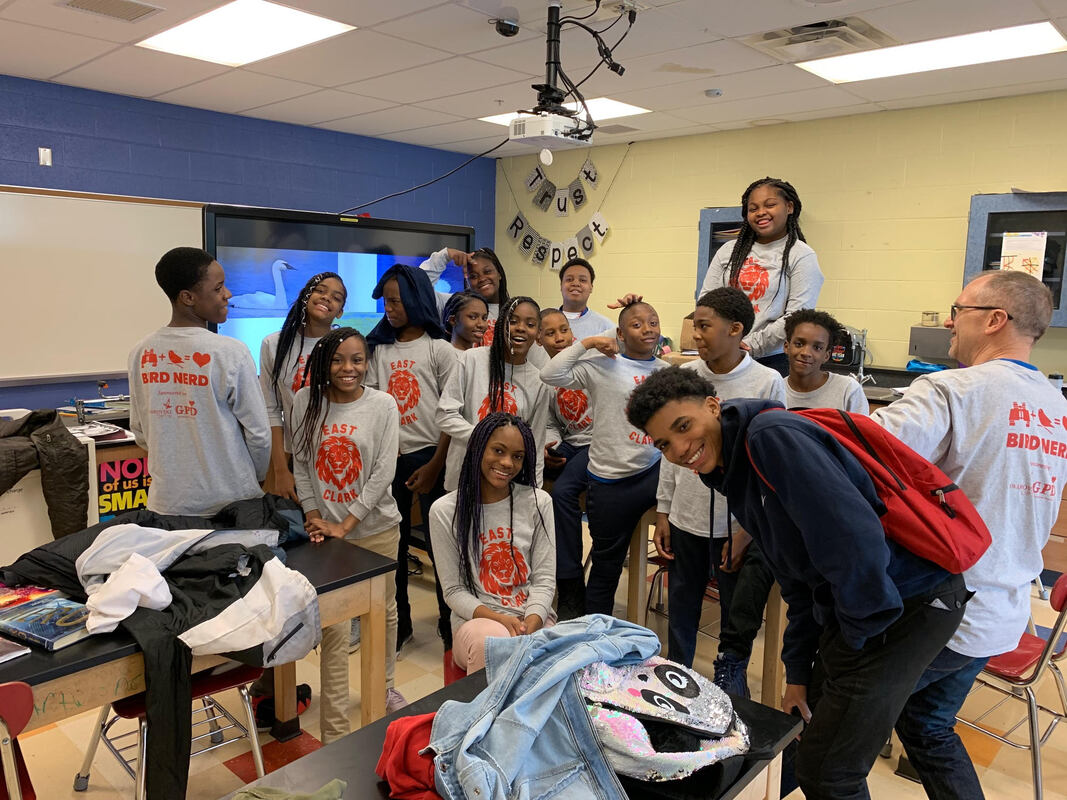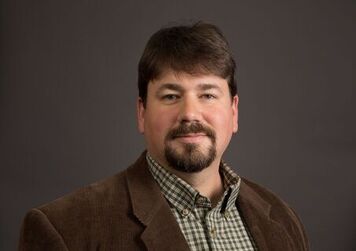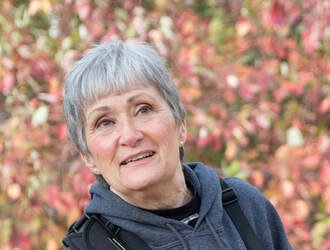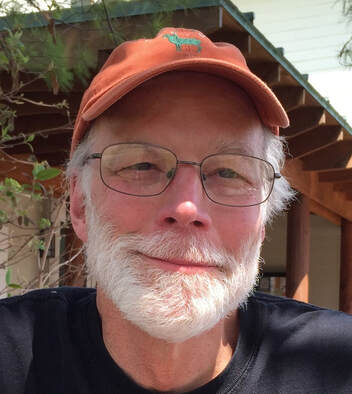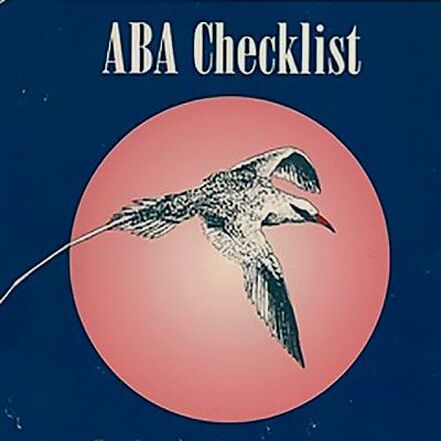PAST Kirtland Bird Club SPEAKER PROGRAMS
|
Wednesday, May 1, 2024
Spying on Kestrels! American Kestrel Conservation at The Wilds Click HERE to view the video Presenter: Genelle Uhrig, M.Sc Location: Western Reserve Land Conservancy Headquarters 3850 Chagrin River Road, Moreland Hills, OH We learned about the current status of American Kestrels, a species of concern in Ohio, and how The Wilds has strived to conserve this species as well as others across reclaimed and restored minelands. Our speaker wasGenelle Uhrig, the young ecologist who received a grant from KBC’s Ohio Avian Project Initiative (OAPI) for her research on American Kestrels. A bird walk in on the Bridle Trail in South Chagrin Reservation preceded Genelle's talk. |
|
Genelle Uhrig, M.Sc., Director of Ecology at
The Wilds in Cumberland, OH, is a Conservation Biologist with 8 years of experience in field ecology and conservation genetics. She specializes in non-invasive genetic studies utilizing scat and environmental DNA (eDNA) for species and individual ID, and parentage analyses. She obtained a Bachelor of Science degree in Fisheries and Wildlife from Michigan State University and a Master of Science degree in Biological Sciences from the University of Wisconsin Milwaukee. Ms. Uhrig has worked with a variety of aquatic and terrestrial wildlife species and currently works with native species reintroduction efforts at The Wilds, including Eastern hellbenders and the federally threatened, state endangered American burying beetle. In addition to working with native Ohio wildlife species, Ms. Uhrig also oversees restoration efforts at The Wilds. |
Wednesday, April 3, 2024 - recording available HERE soon.
LBJs – Sparrows and Finches of NE Ohio
LBJs – Sparrows and Finches of NE Ohio
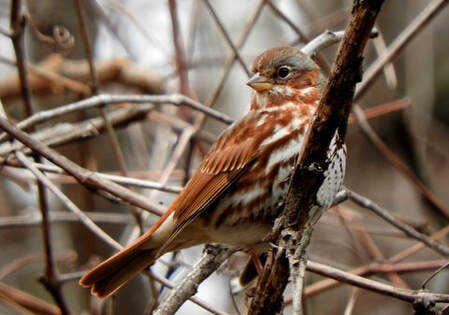 Fox Sparrow - photo by Jim Heflich
Fox Sparrow - photo by Jim Heflich
Presenter: Matt Valencic
Little Brown Jobs. That's how many of us identify sparrows and finches, mostly because they are LBJs! But each of the 28 species we find in northeast Ohio has one or more features to help lead to its identity. Through lots of photographs this program introduced us to these small birds, where to find them, when to expect to see them, and how to separate them from similar species. As Matt said, it was time to put a name to the face.
Click HERE to see the list of species Matt reviewed
- and when to expect them along with Matt's tips for identification.
Little Brown Jobs. That's how many of us identify sparrows and finches, mostly because they are LBJs! But each of the 28 species we find in northeast Ohio has one or more features to help lead to its identity. Through lots of photographs this program introduced us to these small birds, where to find them, when to expect to see them, and how to separate them from similar species. As Matt said, it was time to put a name to the face.
Click HERE to see the list of species Matt reviewed
- and when to expect them along with Matt's tips for identification.
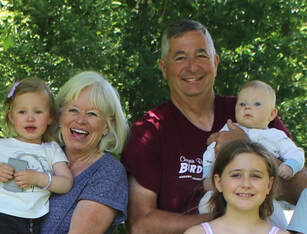
Matt Valencic is a long-time birder as well as photographer, native plant enthusiast, educator, and Kirtland Bird Club member. Matt is very active in educational programming for his "home" club, the Audubon Society of Cleveland and is the force behind Birdquest, a 24 hour team challenge to find the most possible species in the Chagrin River Watershed. He is exceedingly generous with his time and has given speaker programs and led field trips for Kirtland Bird Club. When he's not out birding or documenting his sightings on ebird or doing a program or field trip or tending his garden, he can be found baking with his granddaughter or spending time with one of his other family members.
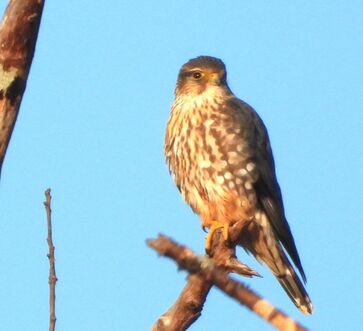 Merlin - photo by Ken Vinciquerra
Merlin - photo by Ken Vinciquerra
Wednesday, March 6, 2024
Birding in the University Circle Area of Cleveland - Part 2 of 2
Presenters: Ken Vinciquerra and Louise Acheson
Watch the recording HERE
KBC members Ken Vinciquerra and Louise Acheson guided us through three greenspaces in our area where scenic gorges, ravines, a “Great Meadow,” and large numbers of mature trees are found. Our presenters highlighted the areas and habitat features that attract these birds and shared historical notes about the organizations and people whose proactive stewardship allows these areas and their birds to endure.
The first area was the East Cleveland Township Cemetery, between the Dugway and Doan Brook watersheds. The other two, both in the Dugway watershed, were Lakeview Cemetery and Forest Hill Park. These areas are accessible through Cleveland, East Cleveland, and Cleveland Heights and are open to the public during the day.
Click HERE to review Ken Vinciquerra's Bird Survey of East Cleveland Township Cemetery April 2015 to December 2015.
Birds found in these areas include year-round residents, summer nesting species, and non-nesting migratory species in the spring, fall, and winter. These include Red-headed and Pileated woodpeckers, Red-breasted Nuthatches, Yellow-bellied Sapsuckers, Brown Creepers, multiple species of raptors, and many songbirds.
Also included was an update to their Part 1 presentation from April 4, 2023. Scroll down to find it. It included the first-time breeding birds and other new developments observed in Doan Brook Park during the 2023 breeding season.
Birding in the University Circle Area of Cleveland - Part 2 of 2
Presenters: Ken Vinciquerra and Louise Acheson
Watch the recording HERE
KBC members Ken Vinciquerra and Louise Acheson guided us through three greenspaces in our area where scenic gorges, ravines, a “Great Meadow,” and large numbers of mature trees are found. Our presenters highlighted the areas and habitat features that attract these birds and shared historical notes about the organizations and people whose proactive stewardship allows these areas and their birds to endure.
The first area was the East Cleveland Township Cemetery, between the Dugway and Doan Brook watersheds. The other two, both in the Dugway watershed, were Lakeview Cemetery and Forest Hill Park. These areas are accessible through Cleveland, East Cleveland, and Cleveland Heights and are open to the public during the day.
Click HERE to review Ken Vinciquerra's Bird Survey of East Cleveland Township Cemetery April 2015 to December 2015.
Birds found in these areas include year-round residents, summer nesting species, and non-nesting migratory species in the spring, fall, and winter. These include Red-headed and Pileated woodpeckers, Red-breasted Nuthatches, Yellow-bellied Sapsuckers, Brown Creepers, multiple species of raptors, and many songbirds.
Also included was an update to their Part 1 presentation from April 4, 2023. Scroll down to find it. It included the first-time breeding birds and other new developments observed in Doan Brook Park during the 2023 breeding season.
|
Ken Vinciquerra, a life-long Clevelander and amateur naturalist, has explored the region's abundant rich forests and waterways for over fifty years. Through the mentorship & friendship of a few special individuals, he gradually evolved from being a "birdwatcher" to a "birder" and eBirder. Since 2015, he's conducted weekly bird surveys and spring/summer breeding bird surveys and, in the process, adding to the existing historical records about bird distribution and breeding success in our area. Ken is a Kent State Emeritus Professor in Computer Technology and volunteers with the Kirtland Bird Club.
|
|
Louise Acheson is a family doctor at University Hospitals and a Professor of Family Medicine and Community Health at CWRU. She remembers watching ducks, alcids, grebes, and eagles as a young woman in the Pacific Northwest, but refined her skills over the past twenty years by birding with Ken. She identifies many birds by sound as well as sight and has learned about birds' habitats and behavior through very patient observation and a meticulous approach to citizen science.
|
Since meeting on the Pierson Creek Trail in Holden Arboretum more than twenty years ago, Ken and Louise have enjoyed exploring the region's extensive preserves and parklands together. They agree that some of their favorite birding experiences have been wading through swamp woods and other unique & special habitats while conducting breeding bird surveys on behalf of the Cleveland Museum of Natural History. Louise and Ken live in University Circle.
Wednesday, February 7, 2024
Click HERE to view recording
Movement Ecology of Henslow's Sparrow
Presenter: Gabriella Lindsey
Click HERE to view recording
Click HERE to view recording
Movement Ecology of Henslow's Sparrow
Presenter: Gabriella Lindsey
Click HERE to view recording
|
Henslow’s Sparrow is a grassland species that has lost 50% of its population since 1960 and is identified as a high conservation priority in Ohio. The main threats to this species are habitat loss and land use change. Disturbance plays an important role in maintaining grassland but can affect how birds use the landscape. Determining how Henslow’s Sparrows use habitats during breeding and post-breeding periods can inform management plans. Gabi and her team mapped detections of nano-tagged and color-banded birds weekly to document territory and habitat use throughout the season and in relation to disturbance: one site was hayed in mid-August while the other was not disturbed. She and her lab estimated 50 and 95 % home range size throughout the season to determine if there were any shifts in habitat use in relation to time or disturbance. She also used automated and manual telemetry to estimate post-breeding dispersal and migratory departure timing of birds from the two fields. Their research will provide data to inform management of grassland habitats that meets the needs of Henslow’s Sparrows.
|
|
Gabriella Lindsey is a fourth year undergraduate student at Ohio University in the Honors Tutorial College. She works with Dr. Kelly Williams in the Williams Avian Ecology Lab. She became interested in working with birds in 2022 and dove into her work head-first. Since joining the lab, she has worked on projects with Swainson’s Thrushes, Dark-eyed Juncos, American Tree Sparrows, American Kestrels, and Henslow’s Sparrows. After completing her undergraduate degree she plans to continue using nanotags on birds to study the effects of artificial light on activity patterns and migration. Gabi was the recipient of grant from Kirtland Bird Club's Ohio Avian Project Initiative grant, which partially funded her research project. |
|
Wednesday, January 3rd, 2024
Birding Basics Presenter: Patty Kellner Click HERE for video recording Were you interested in birds when you were a kid? Do you still like birds? Like a lot of us, Patty did like birds when she was a kid. She loved watching birds at the bird feeder outside her family's kitchen window. She pored over the bird books her mother got for her and wished she lived in a place where more colorful species would visit her bird feeder. What she did not know then was that colorful and interesting bird species were right in her own neighborhood - they just didn't have any interest in visiting bird feeders. |
Patty will talk to us about how she became a birder and try to help people find more ways to learn about and enjoy birds. She'll go over basic concepts to get people started, including where to look for birds, how to look and listen for them, and how to identify them by their appearance and vocalizations. She will also point people to additional resources, including useful websites and phone apps.
|
Patty Kellner, President of Kirtland Bird Club, was a family physician on the east side of Cleveland until she retired. In addition to the time she spends enjoying birds, she continues to advocate for health: quality health care, compassionate health care, health and social equity, healthy habits, healthy environments, healthy air and food, healthy health care workers, healthy relationships, and BIRD HEALTH.
She doesn't have an absolute favorite bird, but the Blackburnian Warbler is high up on her list of favorite birds to see in Cleveland and Northeast Ohio. |
|
Wednesday, December 6, 2023
The Joy of Gulls Presenter: Chuck Slusarczyk, Jr. Location: The Fairmount Cocktail Bar 2448 Fairmount Blvd, Cleveland Hts |
We celebrated winter and the amazing gulls of Cleveland's north shore - as aptly described and photographed by Cleveland's own Chuck Slusarczyk! People from all over the state travel to Cleveland's north shore to see the variety of gulls that call Cleveland and Northeast Ohio their winter home. The evening started with hearty appetizers and a chance to socialize with friends old and new in a warm setting.
|
Raised in the Cleveland, Ohio area, Chuck is a life-long birder and wildlife photographer with a passion for all creatures, and flying things in particular. His interest in birds began at a very young age, even before attending his first bird walks in 1975.
The Cleveland Audubon Society honored him with an award at age fifteen for "Outstanding Contribution in the Field of Conservation", and he won a bird identification contest sponsored by the Cleveland Museum of Natural History in the same year. |
Whenever he's not at work driving a charter bus throughout the eastern U.S., you'll find him out in the field somewhere with his ever present binoculars and camera looking for the regular and the rare. Just this past November he discovered the first Ash-throated Flycatcher for the State of Ohio, and has documented the oldest Ring-billed Gull on record, a bird which will be 31 years old this spring. "Always looking and always learning" is his personal motto.
Wednesday, November 1st, 2023 at 7 PM
Wingbeats. An Evening of Birds and Poetry with Nicole Robinson
Location: Loganberry Books
13015 Larchmere Boulevard, Cleveland (near Shaker Square) - parking available
Wingbeats. An Evening of Birds and Poetry with Nicole Robinson
Location: Loganberry Books
13015 Larchmere Boulevard, Cleveland (near Shaker Square) - parking available
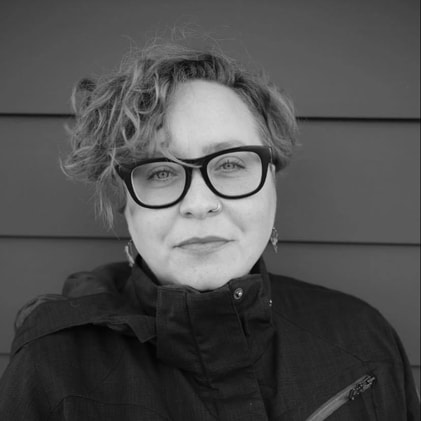
As we leave the warmer lighter months of our year behind, we will gather at Loganberry Books to share an evening of poetry about our favorite subject: birds!
Nicole Robinson's poetry explores a wide range of subjects through an unsentimental yet deeply joyful regard for the natural world, especially birds. Nicole will lead off by reading from her recently published collection, Without a Field Guide, (publisher UnBound Edition Press). Nicole has invited us to bring a poem to share (your own or that of another poet) that reflects on birds and their roles in our lives.
As we enter into the colder darker part of the year, how can reflections on birds sustain us? What birds can we still find and how do they sustain themselves?
Nicole will answer questions after she reads her poetry,
The evening concluded with a book signing. Copies of Nicole's book are available for sale at Loganberry Books.
Nicole Robinson is the author of the the award winning poetry collection, Without a Field Guide (Unbound Edition Press, 2023). Her poems have appeared in Columbia Journal, The Fourth River, Great River Review, The Louisville Review, Tahoma Literary Review, and elsewhere. She is the recipient of an Individual Excellence Award for poetry from the Ohio Arts Council, and the Humanities Award from the American Academy of Hospice and Palliative Medicine. A former high school English teacher in Glenville, Nicole currently serves as the Narrative Medicine Coordinator at Akron Children’s Hospital. She hopes some of her former students will attend this program.
Nicole Robinson's poetry explores a wide range of subjects through an unsentimental yet deeply joyful regard for the natural world, especially birds. Nicole will lead off by reading from her recently published collection, Without a Field Guide, (publisher UnBound Edition Press). Nicole has invited us to bring a poem to share (your own or that of another poet) that reflects on birds and their roles in our lives.
As we enter into the colder darker part of the year, how can reflections on birds sustain us? What birds can we still find and how do they sustain themselves?
Nicole will answer questions after she reads her poetry,
The evening concluded with a book signing. Copies of Nicole's book are available for sale at Loganberry Books.
Nicole Robinson is the author of the the award winning poetry collection, Without a Field Guide (Unbound Edition Press, 2023). Her poems have appeared in Columbia Journal, The Fourth River, Great River Review, The Louisville Review, Tahoma Literary Review, and elsewhere. She is the recipient of an Individual Excellence Award for poetry from the Ohio Arts Council, and the Humanities Award from the American Academy of Hospice and Palliative Medicine. A former high school English teacher in Glenville, Nicole currently serves as the Narrative Medicine Coordinator at Akron Children’s Hospital. She hopes some of her former students will attend this program.
|
Wednesday, October 4th, 2023
Birds, Bugs & Botany Presenter: Judy Semroc Location: Nature Center at Shaker Lakes 2600 South Park Boulevard, Shaker Heights This program illustrated the amazing connections between birds, insects, and plants. Each of these groups uses the others in the natural history of their behavior, food gathering, protection and life cycles. We learned how these important connections can influence human lives, learned about the critical importance of insects, and gave us an opportunity to appreciate the natural world even more. |
|
Judy Semroc has spent more than 30 years chasing, observing, and marveling at the amazing natural history found in Ohio & other states. She is the founder of “Chrysalis in Time,” the first Ohio chapter of the North American Butterfly Association (NABA). Judy also serves on the board of the Ohio Bluebird Society, the Ohio Ornithological Society (Conservation Committee) & the Ohio Biological Survey. She has co-authored two natural history guides, "Dragonflies & Damselflies of Northeast Ohio” and "Goldenrods of Northeast Ohio: A Field Guide to Identification & Natural History.” As a former Petroleum Geologist and science teacher, Judy loves to learn about and share her passion for the natural world through hikes, interpretive programs, and photography. Learn more about Judy’s latest adventures & offerings through her new company, Nature Spark! Website: www.naturesparkohio.com Email: [email protected] |
Wednesday, September 6th, 2023
Ornitherapy: The Power of Birdwatching
Presenter: Holly Merker
Location: The Gathering Place, Beachwood
Presenter: Holly Merker
Location: The Gathering Place, Beachwood
|
Long to-do lists, digital demands - life can be unrelentingly busy! Research shows that connecting with nature actively reduces stress, depression, and anxiety, while helping build a stronger heart and immune system. Birds are gateways into deeper experiences with nature, providing these benefits. When we allow birds and nature to slow us down, we are practicing self-care. During this program, we delved into our connections to birds, how to maximize the wellness benefits of birding, and learned about the latest research surrounding the impact of birds on human well-being.
|
Holly Merker is a long time professional birding guide, author, educator, and lecturer. More recently she has become a global advocate for the practice of Mindful Birding. As author of the award-winning book, Ornitherapy: For Your Mind, Body, and Soul (along with Richard Crossley and Sophie Crossley), Holly guides readers into optimizing the wellness benefits birds provides for us. With a background in Art Therapy and as a Certified Wellness Counselor and Certified Nature and Forest Therapy Guide, Holly also weaves birds into nature-based wellness programs for people of all ages. In 2022 Holly was honored to be the recipient of the ABA Conservation and Education Award given by the American Birding Association for her work in both those areas.
In her free time, Holly spends every possible moment practicing Ornitherapy, which she credits with helping her defeat breast cancer by restoring her health mentally and physically.
Read more about Holly Merker HERE.
Read more about The Mindful Birding Network HERE.
Holly's book, Ornitherapy - for Mind, Body, and Soul, is for sale online.
Kirtland Bird Club of Northeast Ohio was pleased to partner with The Gathering Place for this presentation. The Gathering Place educates and empowers individuals and families currently coping with the impact of cancer in their lives through programs and services provided free of charge.
In her free time, Holly spends every possible moment practicing Ornitherapy, which she credits with helping her defeat breast cancer by restoring her health mentally and physically.
Read more about Holly Merker HERE.
Read more about The Mindful Birding Network HERE.
Holly's book, Ornitherapy - for Mind, Body, and Soul, is for sale online.
Kirtland Bird Club of Northeast Ohio was pleased to partner with The Gathering Place for this presentation. The Gathering Place educates and empowers individuals and families currently coping with the impact of cancer in their lives through programs and services provided free of charge.
Wednesday, May 3, 2023 - Click HERE to view the video recording
|
BINOS and Birding in Northeast Ohio
Presenter: Samuel Bachtel This month's program began with a showing of Binos, a short film by Samuel Bachtel. Inspired by its creator's experiences, the film explored real-life themes, comedic aspects, and experiences of birders. Sam talked about the generous common nature among birders and how binoculars are the ticket into the birding world. |
Sam also spoke about a number of Northeast Ohio birding hot spots to visit any time of the year, especially during spring warbler migration. There are a lot of birds in these places, and Sam shared tips to maximize success in finding and identifying them. Finally, he suggested ways to get more involved in the birding community.
|
Samuel Bachtel, amateur filmmaker and long-time birder, was born and raised in Cuyahoga Falls, Ohio. By age 10, on hikes with his father, he started taking photos of birds, frogs, wildflowers, and moths. After graduating from high school, Sam realized his interests in visual storytelling and spending time in nature meshed perfectly with filmmaking. He taught himself how to make movies and then advanced his craft by earning a degree in Digital, Video, and Media Technology from Stark State College. With those experiences, Sam combined his true passion with his favorite activity and created BINOS.
|
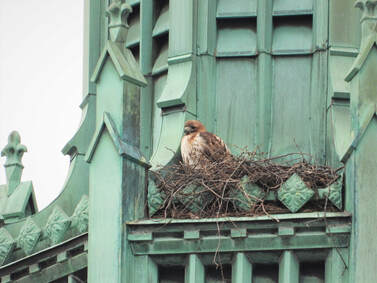
Wednesday, April 5th, 2023 - click HERE to view recording
Birding in the University Circle Area of Cleveland - Part 1 of 2
Presenters: Ken Vinciquerra and Louise Acheson
University Circle contains two riparian corridors, both rich places for birds: the Doan Brook Watershed and the Dugway Brook Watershed. (Read more about these watersheds and see them on a map by clicking HERE soon.)
The Doan Brook watershed hosts a variety of year-round places to bird, including Doan Brook Park. Rockefeller Lagoons Park, and East Cleveland Township Cemetery. Our speakers discussed some of the interesting adaptations various species have made to successfully raise their young at those sites and elsewhere in University Circle. Lastly, they shared a bit of history regarding these unique green spaces and highlighted some of the organizations and people whose proactive stewardship has allowed these spaces to endure.
Part 2, which will include green spaces in the Dugway Brook watershed such as Lakeview Cemetery, will be presented by our speakers at a later date.
Birding in the University Circle Area of Cleveland - Part 1 of 2
Presenters: Ken Vinciquerra and Louise Acheson
University Circle contains two riparian corridors, both rich places for birds: the Doan Brook Watershed and the Dugway Brook Watershed. (Read more about these watersheds and see them on a map by clicking HERE soon.)
The Doan Brook watershed hosts a variety of year-round places to bird, including Doan Brook Park. Rockefeller Lagoons Park, and East Cleveland Township Cemetery. Our speakers discussed some of the interesting adaptations various species have made to successfully raise their young at those sites and elsewhere in University Circle. Lastly, they shared a bit of history regarding these unique green spaces and highlighted some of the organizations and people whose proactive stewardship has allowed these spaces to endure.
Part 2, which will include green spaces in the Dugway Brook watershed such as Lakeview Cemetery, will be presented by our speakers at a later date.
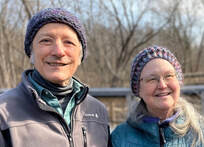
Since meeting on the Pierson Creek Trail in Holden Arboretum more than twenty years ago, Ken Vinciquerra and Louise Acheson have enjoyed exploring the region's extensive preserves and parklands together. They agree that some of their favorite birding experiences have been wading through swampy woods and other unique & special habitats while conducting breeding bird surveys on behalf of the Cleveland Museum of Natural History. Louise and Ken live in University Circle.
Ken, a life-long Clevelander and amateur naturalist, has explored the region's abundant rich forests and waterways for over fifty years. Through the mentorship & friendship of a few special individuals, he gradually evolved from being a "birdwatcher" to a "birder" and eBirder. Since 2015, he's conducted weekly bird surveys and spring/summer breeding bird surveys and, in the process, adding to the existing historical records about bird distribution and breeding success in our area. Ken is a Kent State Emeritus Professor in Computer Technology and volunteers with the Kirtland Bird Club.
Louise is a family doctor at University Hospitals and a Professor of Family Medicine and Community Health at CWRU. She remembers watching ducks, alcids, grebes, and eagles as a young woman in the Pacific Northwest, but refined her skills over the past twenty years by birding with Ken. She identifies many birds by sound as well as sight and has learned about birds' habitats and behavior through very patient observation and a meticulous approach to citizen science.
Louise is a family doctor at University Hospitals and a Professor of Family Medicine and Community Health at CWRU. She remembers watching ducks, alcids, grebes, and eagles as a young woman in the Pacific Northwest, but refined her skills over the past twenty years by birding with Ken. She identifies many birds by sound as well as sight and has learned about birds' habitats and behavior through very patient observation and a meticulous approach to citizen science.
|
Wednesday, March 1, 2023 - Click HERE to view video
Turn Your Home Garden into a Healthy Habitat for Birds Speaker: Laura Erickson Many of us attract birds to our yards with bird feeders, but most species nesting and passing through Ohio don’t visit feeders, and even the ones that do need natural habitat as well. Native birds depend on native plants for nutrition, shelter, safety, and sometimes even water. Some birds have important connections with certain plants, such as American Goldfinches with native thistles, Gray Catbirds and Brown Thrashers with dogwood and other native berries, Blue Jays and Wood Ducks with oaks, Bald Eagles with white pine, and Kirtland’s Warblers with jack pine. Laura Erickson shared these facts and more during her presentation to Kirtland Bird Club members and guests. |
|
Laura Erickson has studied the associations between plants and birds since she started birding in 1975. Her new book and this program highlight ways we can all create backyard habitat to safely attract and nurture birds, with photos and information about some of the plants she recommends and the birds attracted to them. Though Laura lives in Minnesota, all of the plants and birds she’ recommended during this program are native to Ohio. A past Kirtland Bird Club presenter, Laura Erickson was as informative and enjoyable as ever.
|
|
February 1, 2022 - Click HERE to view video
Ecuador and the Galapagos Islands Speaker: Anna Kozlenko Charles Darwin’s observations of Galápagos species in 1835 was the inspiration for his theory of evolution. The isolated terrain of the Galapagos Islands shelters a diversity of plant and animal species, many found nowhere else. Ecuador, including the Galápagos Islands, has 1617 confirmed species. Eight of these species are endemic to the mainland and 31 are |
endemic to the Galápagos Islands, with 4 species introduced by humans. Seventy-seven species are rare or vagrants, and one has been extirpated.
In November 2022 Anna Kozlenko spent 9 days in Ecuador, two on the mainland and seven in the Galápagos Islands on a trip organized by Mercedes Rivadeneira, owner of Puembo Birding Garden and Safaris Company. Anna’s presentation included her photographs and videos.
In November 2022 Anna Kozlenko spent 9 days in Ecuador, two on the mainland and seven in the Galápagos Islands on a trip organized by Mercedes Rivadeneira, owner of Puembo Birding Garden and Safaris Company. Anna’s presentation included her photographs and videos.
|
Anna Kozlenko received a PhD in Zoology from the Russian Academy of Science and studied bird
populations in Central Siberia before moving to the United States in the 1990s. Over the 28 years she's been in the US Anna worked mostly as a software quality analyst. During her career and in retirement, Anna has volunteered extensively for the Cleveland Metroparks, Cleveland Museum of Natural History, Friends of Euclid Creek, Friends of Lower Lake, and Bellefaire JCB’s mentoring program for children in foster care. Anna lives in South Euclid and is a Board member of the Kirtland Bird Club of Northeast Ohio. |
Wednesday, January 4, 2023 - click HERE to view video recording
Climate Watch - a citizen science program of the National Audubon Society
Speaker: Mary Anne Romito, Climate Watch Coordinator for Northeast Ohio
Climate Watch - a citizen science program of the National Audubon Society
Speaker: Mary Anne Romito, Climate Watch Coordinator for Northeast Ohio
|
Audubon’s 2019 climate change report, ‘Survival By Degrees,’ says that up to two-thirds of North American birds are at risk for extinction due to rising temperatures. The National Audubon Society is working to document the effects of climate change in the hopes that this will lead to environmental policy that will help save birds from this terrible fate.
|
|
Mary Anne Romito, Climate Watch Coordinator for Northeast Ohio and Kirtland Bird Club treasurer, shared data collected through the program over the past 6 years and described how Northeast Ohioan birders, in groups of 2 or 3, collect data during a single 4 hour period in January and again in May. This data will contribute to the vast database Audubon is building. The species that will be surveyed are specific to our area. This program is for people of all levels of birding ability, though all participants must be able to identify the species being sought. For more info contact Mary Anne Romito via [email protected].
|
|
Wednesday, December 7, 2022 - Click HERE to view recording Birds of Glacier National Park Speaker: Kyler Sonney Unique species of Glacier National Park and where to find them. More than 260 species of birds have been seen in Glacier National Park. Birds we heard about included Harlequin Duck, American Dipper, Pacific Wren, Clark's Nutcracker, White-tailed Ptarmigan, Black Swift, Gray-crowned Rosy-finch, American Pipits, and Black-backed and Three-toed Woodpecker Click HERE to see a checklist of Glacier National Park birds. |
|
Kyler Sonney started life in Erie, PA and became interested in birding
in college. He attended Pennsylvania State University where he graduated with a bachelor's degree in Recreation, Parks and Tourism Management. He also has an Associate degree in Wildlife Technologies. While in school he worked as a wildlife tech with flat-tailed horned lizards in Arizona and with bats all over Pennsylvania. He went on to do environmental education in many places and is just coming back to the Cleveland area after working as a seasonal educational guide in Glacier National Park. |
|
Wednesday, November 2, 2022 Fall Migration at Cape May Bird Observatory Speaker: Gautam Apte Morning Flight Counter at CMBO Click HERE to view recording |
Gautam Apte, a native Clevelander and eBird reviewer for several counties in Ohio, spent the Fall of 2022 documenting migration at Cape May Bird Observatory - counting birds by species as they flew by his station at Higbee Beach.
During college Gautam managed the avian window collision monitoring program while in college at the Ohio State University. While at OSU completed his own research project, studying influences on migratory behavior in Song Sparrows. During college breaks Gautam worked as a field biologist collecting data for various research studies across the country. He graduated with a BS in Forestry, Fisheries, and Wildlife Science.
During college Gautam managed the avian window collision monitoring program while in college at the Ohio State University. While at OSU completed his own research project, studying influences on migratory behavior in Song Sparrows. During college breaks Gautam worked as a field biologist collecting data for various research studies across the country. He graduated with a BS in Forestry, Fisheries, and Wildlife Science.
Wednesday, October 5, 2022
No recording was made, but click HERE to view a 26 min CMNH video with the same title & speaker
Mentor Marsh: History, Tragedy, Recovery
Speaker: David Kriska, Biodiversity Coordinator, Cleveland Museum of Natural History
No recording was made, but click HERE to view a 26 min CMNH video with the same title & speaker
Mentor Marsh: History, Tragedy, Recovery
Speaker: David Kriska, Biodiversity Coordinator, Cleveland Museum of Natural History
|
As one of the most species-rich sites on the Great Lakes shoreline, Mentor Marsh is a National Park Service-designated National Natural Landmark (1966). The Marsh was named Ohio’s first State Nature Preserve in 1971 and is a National Audubon Society Important Birding Area. This 806-acre wetland suffered dramatically in 1966 when salt-mine tailings leached into Blackbrook Creek. By 1973 most of the swamp forest trees and marsh plants had died, and the 4-mile-long wetland basin was overtaken by reed grass (Phragmites australis), a 15’ to 24’ tall nonnative invasive plant from Eurasia.
|
The Cleveland Museum of Natural History began the large-scale restoration of Mentor Marsh in 2015. Guided by Museum restoration ecologists, the Phragmites monoculture was sprayed with an aquatic-safe herbicide and then physically mashed flat to allow native plants to grow. Over 180 species of native plant species have been documented sprouting from the soil seed bank, including 3 state-listed plants. Rare marsh birds—such as American and Least Bitterns, and Virginia, King and Sora Rails are nesting, and wading birds and waterfowl are now abundant. Yellow Perch fingerlings are now using the Marsh as a nursery and Northern Pike are spawning. We heard about recent restoration updates and the challenges of working "waist deep in the muck"!
|
David Kriska joined the Museum in 2003 working for the Natural Areas Division. He specializes in rare plant and animal surveys, community ecology, and habitat restoration.
Since 2008 he’s helped the Natural Areas Division acquire nearly 2,000 acres of critical habitat- the Museum currently has 66 scientific natural areas spread across 12,000 acres that contain unique natural communities, such as old growth forests, marshes, bogs, swamps and fens. These high-quality habitats, many of which are globally rare, together protect 250 different kinds of endangered, threatened, or rare plant and animal species, and represent the remarkable biological diversity that was once widespread throughout the region. |
Wednesday, September 14th, 2022 - recording available through 9/21/22 - contact us HERE for access
Owls of the Eastern Ice
Speaker: Jonathan C. Slaght
Owls of the Eastern Ice
Speaker: Jonathan C. Slaght
|
From 2006-2010, Jonathan Slaght studied Blakiston’s fish owls in Russia for his PhD degree at the University of Minnesota. Slaght’s memoir of his experiences, called “Owls of the Eastern Ice,” was published by Farrar, Straus, and Giroux in summer 2020 to acclaim. It was named a New York Times Notable Book for 2020, longlisted for a 2020 National Book Award, one of the ten best books of 2020 by the Wall Street Journal, and won the 2021 PEN/E.O. Wilson Literary Science Writing Award. Here, he will describe the owls and his project, including vivid details of the adventures and struggles described in the book, and on-going conservation efforts with this endangered species.
|
|
Jonathan Slaght is the Director of Conservation for the Russia Program of the New York-based Wildlife Conservation Society (WCS). His duties include strategic planning, oversight, and technical support for the development and implementation of conservation priorities in Russia, with a focus on Amur tigers, leopards, Blakiston’s fish owls, and other iconic wildlife.
Slaght’s writings have been featured in The New York Times, Audubon Magazine, and The Guardian, among other outlets, and in 2016 he translated a 1921 Russian classic by Vladimir Arsenyev called Across the Ussuri Kray for Indiana University Press. Owls of the Eastern Ice was his first book. |
This event was co-sponsored by Kirtland Bird Club and Western Reserve Land Conservancy.
Wednesday, September 7th - video recording coming soon!
|
Early Fall Migrants & the Chagrin River Bird Quest
Speaker: Matt Valencic Location: Nature Center at Shaker Lakes 2600 South Park Blvd, Shaker Heights In the outdoor covered pavilion next to the parking lot Signs for additional parking locations will be posted *We birded at the Nature Center at Shaker Lakes before the meeting - check out KBC's ebird checklist and photo of an Olive-Sided Flycatcher. |
Avid birder, photographer, educator, and KBC member Matt Valencic will talk to us about late summer birding and the Chagrin River Bird Quest, a fun event that's now in its 8th year. Matt will explain how we can participate, see some great birds, and help support the Chagrin River IBA (Important Bird Area).
Chagrin River Bird Quest takes place between 4 PM Friday, September 9th and 4 PM Saturday, September 10th. Bird Quest concludes with a celebration at West Woods Park in Novelty from 4-6 PM on Saturday. Birders of all levels of experience are welcome at this event and the associated program!
Click HERE for more details and to register for Chagrin River Bird Quest.
Chagrin River Bird Quest takes place between 4 PM Friday, September 9th and 4 PM Saturday, September 10th. Bird Quest concludes with a celebration at West Woods Park in Novelty from 4-6 PM on Saturday. Birders of all levels of experience are welcome at this event and the associated program!
Click HERE for more details and to register for Chagrin River Bird Quest.
|
Wednesday, May 4, 2022 - Click HERE for video
The Bird Specimen Collection of the Cleveland Museum of Natural History Presenter: Courtney Brennan, Senior Collections Manager This was the first live KBC meeting in 2 years! Courtney talked about the museum's collections - the source of birds, the preparation and storage of bird specimens, and the research that's done with the specimens. Many of the birds in the collection come from Lights Out Cleveland, a group that attempts to rescue bird victims of window collisions in downtown Cleveland. Live birds from those rescue efforts go to Lake Erie Nature & Science Center for rehab. The museum gets the dead birds (which way outnumber the live birds) and those birds are used to augment the museum's specimen collection and for research studies around the world. Courtney showed specimens of Spring migrants and also demonstrated live how specimens are prepared. |
Wednesday, April 6, 2022 - Click HERE to view video
Weather Conditions and Migration: Target Birds and Birding
Presenter: Gautam Apte
Weather Conditions and Migration: Target Birds and Birding
Presenter: Gautam Apte
Beyond the basics of annual migratory behavior, this was an in-depth look at the concept of migration and the influence of weather conditions on a wide range of migratory species. Ideal conditions for the best “fallout” experience, the best times to look for uncommon or scarce migrants, and even how to maximize chances of finding a rarity in a particular local patch were reviewed. Tips for finding a few highly sought-after species were discussed. Included in this discussion were analysis of historical records, weather conditions, and patterns of occurrence to determine what conditions yield the highest probability of a species being seen in a particular area. Gautam shared how to evaluate data like this for any given species or group, and how to apply those findings in the field and get the most out of birding an barea!
|
Gautam Apte has been enjoying the Cleveland birding scene for over a decade, where he began birding at a young age. He is currently finishing up a B.S. in Forestry, Fisheries, and Wildlife Science at The Ohio State University in Columbus, where he is the Vice President of Conservation for the Ornithology Club. He serves as an eBird reviewer for several counties in Ohio and manages the avian window collision monitoring program at OSU, as well as his own research project, studying influences of migratory behavior in Song Sparrows. In the summers, he has worked as a field biologist collecting data for various research studies across the country. During the school year, he enjoys studying migration in and around the Cleveland area, particularly observing waterbird migration along the Lake Erie coast in the fall and winter. Besides birding, he enjoys traveling, hiking, climbing, and being let down by the Browns every year.
|
Wednesday, March 2, 2022 - Click HERE to view video
Birds in Music: Olivier Messiaen and his Birdsong Compositions
Presenter: Sameer Apte
Birds in Music: Olivier Messiaen and his Birdsong Compositions
Presenter: Sameer Apte
|
Cellist Sameer Apte, an active Cleveland birder and incoming doctoral student at the University of Southern California will discuss ornithologically-inspired pieces by the French composer Olivier Messiaen. Many of Messiaen's pieces are structured around quotations of birdsong, which he claimed to have transcribed from the field. Recent research, however, has revealed that many of Messiaen's quotations were actually transcribed from recordings. Apte will introduce some of Messiaen's most compelling birdsong pieces and examine how they fit into the historical context of bird identification and recording.
|
|
American cellist Sameer Apte was born in 1997 in Cleveland, Ohio. An active performer in the Cleveland area, Apte will begin his doctoral studies with Professor Ralph Kirshbaum in Fall 2022 at the University of Southern California.
An eager participant in all aspects of contemporary performance, has performed with the Aeolus Quartet, alongside members of the Pittsburgh, Cleveland, and St. Louis symphony orchestras, and has collaborated as soloist with conductors Carl Topilow, Stephen Schultz, and Gerard Schwarz. Apte was a 2021 fellow at the Aspen Music Festival, where he performed in the Aspen Chamber Symphony and joined the Aspen Contemporary Ensemble. As 2019 fellow of the Tanglewood Music Center and as 2017 fellow of the Pacific Music Festival, Apte served as principal of both festival orchestras. In 2021, Apte earned his master’s degree from the New England Conservatory. Previously, Apte studied cello at Carnegie Mellon University, with additional studies in chamber music. |
Outside of music, Apte enjoys reading, running, chess, and looking for wildlife outdoors. He regularly contributes to citizen science databases such as ebird and other ecological research projects.
______________________________________________________________________________________________________________________________
Immediately following this presentation (around 8:15 PM), those interested in BIRD SAFETY and BIRD HABITAT will remain on Zoom to learn about and get updates on issues important to birders and to discuss ways we can be impactful.
We will hear about and provide input for a NEORSD project to turn Ridgewood Park Lake in Parma into a wetland, get an update on bird-unsafe reflective glass in the plans for the Sherwin Williams headquarters tower in downtown Cleveland and a go-kart racetrack proposed on the site of Cromwell Park, an IBA (Important Bird Area), in Lorain.
______________________________________________________________________________________________________________________________
Immediately following this presentation (around 8:15 PM), those interested in BIRD SAFETY and BIRD HABITAT will remain on Zoom to learn about and get updates on issues important to birders and to discuss ways we can be impactful.
We will hear about and provide input for a NEORSD project to turn Ridgewood Park Lake in Parma into a wetland, get an update on bird-unsafe reflective glass in the plans for the Sherwin Williams headquarters tower in downtown Cleveland and a go-kart racetrack proposed on the site of Cromwell Park, an IBA (Important Bird Area), in Lorain.
Wednesday, February 2, 2022 - View the recording HERE
Threatened Cranes in the Amur Region of Far Eastern Russia
Socio-environmental Challenges & Solutions
Presenters: Dr. Sergei and Elena Smirenski,
Co-Founders of Muraviovka Park for Sustainable Land Use in the Amur Region of Russia
Threatened Cranes in the Amur Region of Far Eastern Russia
Socio-environmental Challenges & Solutions
Presenters: Dr. Sergei and Elena Smirenski,
Co-Founders of Muraviovka Park for Sustainable Land Use in the Amur Region of Russia
|
Building on the work of Sergei and Elena Smirenski, and through collaboration with the International Socio-Ecological Union, the International Crane Foundation, and others, Muraviovka Park for Sustainable Land Use was established in 1994 as the first privately-managed protected area in the Soviet Union. A year later this land and adjacent areas were added to the list of Wetlands of International Importance by the Ramsar Convention.
Muraviovka Park boasts over 700 species of vascular plants and over 300 species of birds, including six species of cranes. It is a critically important area for White-naped, Red-crowned and Hooded Cranes, |
Oriental White Stork, Yellow-breasted Bunting, and other avian species on the International Union for Conservation of Nature Red List of Threatened Species. The park's activities include monitoring numbers of wild cranes, managing a captive breeding program of endangered cranes to release the cranes into the wild. The park works to prevents forest fires, conducts reforestation, organizes annual international summer camps at Muraviovka Park and in other parts of the Amur River Basin, including China, hosts tourists, and organizes festivals. The 16,000 acres on which this park sits is leased to the park through 2058. Sergei and Elena will update us on the park and its inhabitants.
|
Sergei's love of birds started in childhood. In 1970 he began studying the birds of Russia's Far East at Moscow State University, graduating in 1973 and receiving his PhD in Zoology in 1986. Elena graduated from Moscow's Teachers Institute in 1972. She worked as an editor and chief of the editorial staff of the Zoological Journal of the USSR's Academy of Science. In 1980 Sergei and Elena and Sergei Winter established the Crane Working Group of the USSR, the first species-oriented non-government organization in the Soviet Union. Twelve years later with support from the International Crane Foundation (ICF) in Wisconsin, they organized an International Workshop about the cranes and storks of the Amur River Basin.
|
The Friends of Muraviovka Park, a volunteer group established in 1998, provides important monetary and in-kind support to the park's activities and development. Read a Report from 2014 on Muriviovka Park 11 years after it was established.
Wednesday, January 5, 2022 - View the recording HERE
Ornithology News and Discoveries from 2022
Presenter: Dr. Andy Jones
Ornithology News and Discoveries from 2022
Presenter: Dr. Andy Jones
|
Dr. Andy Jones, curator of ornithology at Cleveland Museum of Natural History, gave his annual update on what's new in ornithology. There are thousands of academic papers published every year on the biology of birds. These new discoveries are sometimes highlighted in newspapers, magazines, and on your Facebook feed, but far too many simply don't get the public attention that they deserve. Dr. Jones spoke about some of his research, including his work with Lights Out Cleveland, and about the value of sharing unusual behaviors seen - not just unusual birds seen. And as always, he highlighted fascinating new technologies available for studying birds.
|
Dr. Andy Jones holds the William A. and Nancy R. Klamm Chair and is Curator of Ornithologist at the Cleveland Museum of Natural History. He received his BS in Biological Sciences from the University of Tennessee at Knoxville, and his PhD in Ecology, Evolution, and Behavior from the University of Minnesota. Dr. Jones originally hails from east Tennessee, where his passion for natural history began at an early age; his first field notes were a count of toads in his front yard at age five. His current research involves the evolutionary history of birds, diagnosing new hybrid combinations, and migration insights from Lights Out Cleveland. Dr. Jones is responsible for the Museum’s collection of avian specimens, which consists of over 35,000 study skins as well as thousands of nests, eggs, and skeletons. His other tasks include providing various services to the scientific community, the media, the Museum’s exhibitions and education divisions and the public at large. Dr. Jones has served as the Secretary of the American Ornithological Society since 2014, and in 2017 was elected as a Fellow of that organization.
Wednesday, December 1, 2021 - view the recording HERE
Topic: Bird Rehabilitation
b
Presenter: Tim Jasinski, Wildlife Rehabilitation Specialist at Lake Erie Nature and Science Center
Topic: Bird Rehabilitation
b
Presenter: Tim Jasinski, Wildlife Rehabilitation Specialist at Lake Erie Nature and Science Center
|
Our December speaker was Tim Jasinski from Lake Erie Nature and Science Center. He told us about the work he does there - rehabbing birds that people find injured or in some other way incapacitated - including birds injured in collisions with buildings during migration. He works closely with Lights Out Cleveland and shared an update on Lights Out Cleveland as well.
Tim has been a “bird nerd” since around the age of five. He had feeders up and would mark in his field guide what species he had seen. He raised and bred caged birds starting when he was 13 years old, and now raises Homing Pigeons. He started as a volunteer at Lake Erie Nature & Science Center in 2007 and became a full time Wildlife Rehabilitation Specialist in 2013. Wildlife rehabilitation has been a passion of his for over 30 years! With Harvey Webster, he initiated the monitoring program for Lights Out Cleveland in Spring 2017. According to Tim, “Birds Rule!” |
|
Wednesday, November 3, 2021
Cleveland Metroparks Planning for the Next 10 Years A Conversation with a Focus on Birds Presenter: Kelly Coffman, Senior Strategic Planner, Cleveland Metroparks The Cleveland Metroparks is engaging community members in the development of a new 10 year strategic plan. This was an opportunity for the birding community to hear about the process and contribute ideas. We heard about past trail work, land acquisition, conservation efforts, invasive plant management, development of urban areas, and engaging marginalized communities, all of which will continue in the upcoming decade. |
Click HERE to read excerpts from the Cleveland Metroparks website.
|
Wednesday, October 6, 2021 - view recording HERE Plants for Birds and Pollinators Presenter: Matt Valencic, long time birder and educator in Geauga County and Greater Cleveland |
Why do birds and pollinators need our help?
How do native plants figure into the lives of birds and insects?
Matt will shared with us many of the native plants, woody and herbaceous that we can use in our landscapes in Northeast Ohio - and showed us some of the birds these plants attract.
Watch this presentation and you will want to get out and plant something new in your yard or on your property!
Click HERE for more information on Native Plants for Birds
How do native plants figure into the lives of birds and insects?
Matt will shared with us many of the native plants, woody and herbaceous that we can use in our landscapes in Northeast Ohio - and showed us some of the birds these plants attract.
Watch this presentation and you will want to get out and plant something new in your yard or on your property!
Click HERE for more information on Native Plants for Birds
Wednesday, September 1, 2021
Let's Talk - Birdwatching with the Kirtland Bird Club in Northeast Ohio
Let's Talk - Birdwatching with the Kirtland Bird Club in Northeast Ohio
|
Club members shared highlights of birding adventures in NE Ohio and talk about Kirtland Bird Club programs - we talked about our speaker meetings, field trips, introductory birding classes, and shared some great photos. We talked about ways to support birds, people, and the Northeast Ohio area we live in. |
A Conversation with Jim Bissell - Botanist, Naturalist, Conservationist
Wednesday, June 2, 2021 - view recording HERE
Wednesday, June 2, 2021 - view recording HERE
|
Renowned botanist and land preservation specialist Jim Bissell spoke about the rich biodiversity found on properties he conserved in Northeast Ohio over the last 50 years. For Jim' s full bio and a fun photo of Jim click HERE |
Wednesday, May 5th, 2021
|
The Bird Nerds of Collinwood We heard from two of The Bird Nerds, a group of middle students from Collinwood, who learned to bird with their teacher, Buster Banish, on after school and weekend field trips. They've had some terrific adventures and they shared the challenges and triumphs of their journey, including tips and techniques for new birders. Nicole Jackson, environmental educator and co-founder of #BlackBirdersWeek, moderated. |
Wednesday, April 7, 2021 - Click HERE to view video recording
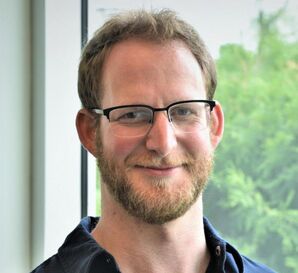
The Evolution of Migration
Presented by Dr. Ben Winger
In the Great Lakes region, we are fortunate to witness the extraordinary spectacle of bird migration each spring and fall. How and why did bird migration evolve? The answer to this question may seem obvious (birds fly south for the winter, of course!) but like any interesting scientific question, the answers become more complex the more we learn. When and where did the migratory patterns we see today originate? How can we possibly answer this question given that birds have a poor fossil record? Why do migratory birds fly so far during migration, only to come back to the very same breeding locations each year? Why don’t more birds hibernate instead of migrating? Dr. Winger discussed research that he has been conducting for the past 15 years on these and other questions related to the evolution of bird migration. He shared with us what he has learned about the evolution of migration and what questions remain difficult to answer. He discussed how learning about the evolution of bird migration informs the conservation of migratory birds in our rapidly changing world.
Presented by Dr. Ben Winger
In the Great Lakes region, we are fortunate to witness the extraordinary spectacle of bird migration each spring and fall. How and why did bird migration evolve? The answer to this question may seem obvious (birds fly south for the winter, of course!) but like any interesting scientific question, the answers become more complex the more we learn. When and where did the migratory patterns we see today originate? How can we possibly answer this question given that birds have a poor fossil record? Why do migratory birds fly so far during migration, only to come back to the very same breeding locations each year? Why don’t more birds hibernate instead of migrating? Dr. Winger discussed research that he has been conducting for the past 15 years on these and other questions related to the evolution of bird migration. He shared with us what he has learned about the evolution of migration and what questions remain difficult to answer. He discussed how learning about the evolution of bird migration informs the conservation of migratory birds in our rapidly changing world.
Dr. Ben Winger is Assistant Professor of Ecology and Evolutionary Biology at the University of Michigan, where he is also the Curator of Birds at the UM Museum of Zoology. Ben is an ornithologist and evolutionary biologist with broad interests in the ecology, behavior and evolution of birds. Ben’s research on the evolution of bird migration has won awards from the American Ornithological Society and the Society of Systematic Biologists and has been featured in popular media such as Radiolab, National Geographic Magazine, and Living Bird.
Ben grew up in Cleveland Heights and graduated from Cleveland Heights High School in 2003. He joined the Kirtland Bird Club at age 13 and credits the KBC and its members with fostering his early interest in birds.
Ben also has a lifelong affiliation with the Cleveland Museum of Natural History, where he is a Research Associate.
Ben received his B.A. from Cornell University in 2007 and his PhD from the University of Chicago in 2015. He and his students at UM study a wide variety of questions related to bird speciation, migration, and conservation.
More about Ben’s research can be found at www.wingerlab.org.
Ben grew up in Cleveland Heights and graduated from Cleveland Heights High School in 2003. He joined the Kirtland Bird Club at age 13 and credits the KBC and its members with fostering his early interest in birds.
Ben also has a lifelong affiliation with the Cleveland Museum of Natural History, where he is a Research Associate.
Ben received his B.A. from Cornell University in 2007 and his PhD from the University of Chicago in 2015. He and his students at UM study a wide variety of questions related to bird speciation, migration, and conservation.
More about Ben’s research can be found at www.wingerlab.org.
Wednesday, March 3, 2021 - click HERE for the video recording of this program
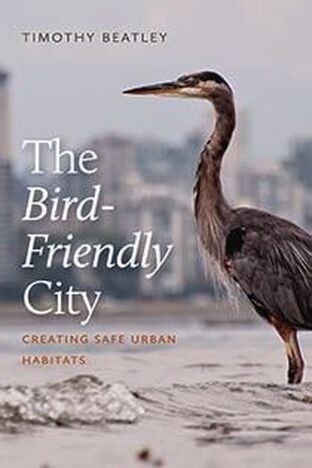
The Bird-Friendly City
Presenter: Dr. Timothy Beatley
How does a bird experience a city? A backyard? A park? As the world has become more urban, noisier from increased traffic, and brighter from streetlights and office buildings, it has also become more dangerous for countless species of birds. Warblers become disoriented by nighttime lights and collide with buildings. Ground-feeding sparrows fall prey to feral cats. Hawks and other birds-of-prey are sickened by rat poison. These name just a few of the myriad hazards. How do our cities need to change in order to reduce the threats, often created unintentionally, that have resulted in nearly three billion birds lost in North America alone since the 1970s?
In The Bird-Friendly City, Timothy Beatley, a longtime advocate for intertwining the built and natural environments, took us on a global tour of cities that are reinventing the status quo with birds in mind. Efforts span a fascinating breadth of approaches: public education, urban planning and design, habitat restoration, architecture, art, civil disobedience, and more. Beatley shared empowering examples, including: advocates for “catios,” enclosed outdoor spaces that allow cats to enjoy backyards without being able to catch birds; a public relations campaign for vultures; and innovations in building design that balance aesthetics with preventing bird strikes. Through these changes and the others Beatley described, it is possible to make our urban environments more welcoming to many bird species.
What he shares motivates us to implement and advocate for bird-friendly changes, with inspiring examples on which to draw. Whether birds are migrating and need temporary shelter or are taking up permanent residence in a backyard, when the environment is safer for birds, humans are happier as well.
Presenter: Dr. Timothy Beatley
How does a bird experience a city? A backyard? A park? As the world has become more urban, noisier from increased traffic, and brighter from streetlights and office buildings, it has also become more dangerous for countless species of birds. Warblers become disoriented by nighttime lights and collide with buildings. Ground-feeding sparrows fall prey to feral cats. Hawks and other birds-of-prey are sickened by rat poison. These name just a few of the myriad hazards. How do our cities need to change in order to reduce the threats, often created unintentionally, that have resulted in nearly three billion birds lost in North America alone since the 1970s?
In The Bird-Friendly City, Timothy Beatley, a longtime advocate for intertwining the built and natural environments, took us on a global tour of cities that are reinventing the status quo with birds in mind. Efforts span a fascinating breadth of approaches: public education, urban planning and design, habitat restoration, architecture, art, civil disobedience, and more. Beatley shared empowering examples, including: advocates for “catios,” enclosed outdoor spaces that allow cats to enjoy backyards without being able to catch birds; a public relations campaign for vultures; and innovations in building design that balance aesthetics with preventing bird strikes. Through these changes and the others Beatley described, it is possible to make our urban environments more welcoming to many bird species.
What he shares motivates us to implement and advocate for bird-friendly changes, with inspiring examples on which to draw. Whether birds are migrating and need temporary shelter or are taking up permanent residence in a backyard, when the environment is safer for birds, humans are happier as well.
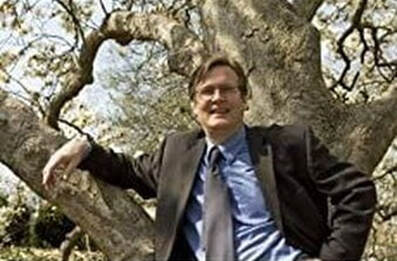
Timothy Beatley is the Teresa Heinz Professor of Sustainable Communities, in the Department of Urban and Environmental Planning, School of Architecture at the University of Virginia, where he has taught for the last twenty-five years. Much of Beatley’s work focuses on the subject of sustainable communities, and creative strategies by which cities and towns can fundamentally reduce their ecological footprints, while at the same time becoming more livable and equitable places. Beatley believes that sustainable and resilient cities represent our best hope for addressing today’s environmental challenges.
To learn more about this topic go to biophiliccities.org for examples from around the world
To learn more about this topic go to biophiliccities.org for examples from around the world
Wednesday, February 3rd at 7:30 PM - no video recording of meeting is available - sorry about that!
The CHEERS Development Plan for Cleveland's Eastern Lakefront
Opportunities for Birds and Birders
Click HERE for material related to CHEERS - including videos
Click HERE to take the CHEERS SURVEY - survey is open to all!
The CHEERS Development Plan for Cleveland's Eastern Lakefront
Opportunities for Birds and Birders
Click HERE for material related to CHEERS - including videos
Click HERE to take the CHEERS SURVEY - survey is open to all!

Planners from Cleveland Metroparks and Port of Cleveland shared several exciting possibilities for this area with our group. They represented two of five partners (Cleveland Metroparks, the Ohio Departments of Natural Resources and Transportation, City of Cleveland, and Port of Cleveland) in a year-long planning study called CHEERS (the Cleveland Harbor Eastern Embayment Resilience Study).
The CHEERS area includes an Important Bird Area: Cleveland Lakefront Nature Preserve (CLNP). Birders have recorded 282 species of birds at CLNP, and this rivals world-famous Magee Marsh, farther west on Lake Erie, where 288 species have been seen.
The CHEERS area also includes the land and water stretching west to Burke Lakefront Airport . Birders regularly search this stretch of the lake for aquatic species and this is the area where exciting possibilities - for things like wetlands - were discussed.
During the presentation on Wednesday, February 3rd members of the birding community had an opportunity to provide input to planners - much as they did at the start of the 21st century when they convinced planners to turn a landfill site into the Cleveland Lakefront Nature Preserve.
The story of Cleveland Lakefront Nature Preserve goes back to 1979, when a Confined Disposal Facility called Dike 14 was built along the southern edge of Lake Erie. It was built to house dredging from the nearby Cuyahoga River and it gradually filled up over the next 20 years. During that time vegetation appeared, and migratory birds and other wildlife were attracted to the site. Around the start of the 21st century Kirtland Bird Club and other local birding and nature groups focused attention on the importance of Dike 14 to migratory birds and the birding community and urged that it be preserved as a nature site. In 2012 Dike 14 was renamed and opened to the public as Cleveland Lakefront Nature Preserve.
Wednesday, January 6, 2021 - video available HERE
Ornithology News and Discoveries from 2020
Presenter: Dr. Andy Jones
Ornithology News and Discoveries from 2020
Presenter: Dr. Andy Jones
|
Dr. Andy Jones returned for his annual talk to the Kirtland Bird Club to highlight recent exciting findings from the world of ornithology. There are thousands of academic papers published every year on the biology of birds. These new discoveries are sometimes highlighted in newspapers, magazines, and on your Facebook feed, but far too many simply don't get the public attention that they deserve. Dr. Jones will highlight the taxonomic changes that birders will want to know about, as well as other discoveries that will simply make us more observant and more informed birders.
|
Dr. Andy Jones holds the William A. and Nancy R. Klamm Chair and Curator of Ornithologist at the Cleveland Museum of Natural History. He received his BS in Biological Sciences from the University of Tennessee at Knoxville, and his PhD in Ecology, Evolution, and Behavior from the University of Minnesota. Dr. Jones originally hails from east Tennessee, where his passion for natural history began at an early age; his first field notes were a count of toads in his front yard at age five. His current research involves the evolutionary history of birds, diagnosing new hybrid combinations, and migration insights from Lights Out Cleveland. Dr. Jones is responsible for the Museum’s collection of avian specimens, which consists of over 35,000 study skins as well as thousands of nests, eggs, and skeletons. His other tasks include providing various services to the scientific community, the media, the Museum’s exhibitions and education divisions as well as the public at large. Dr. Jones has served as the Secretary of the American Ornithological Society since 2014, and in 2017 was elected as a Fellow of that organization.
|
Winter Birds and Birding
in Northern Minnesota Presenter: Laura Erickson From Boreal and Great Gray Owls to Boreal Chickadees and Hoary Redpolls, you never know what birds are going to show up in northern Minnesota in winter, but they’re sure to be interesting. Laura Erickson, who has lived in Duluth for four decades, will talk about the area specialties and the best strategies for finding each one, how they survive as the temperature plummets to 40 below and colder, and how birders can survive looking for them in those conditions. |
Laura Erickson is author of the ABA Field Guide to Birds of Minnesota, 101 Ways to Help Birds, Into the Nest: Intimate Views of the Courting, Parenting, and Family Lives of Familiar Birds, and the brand new Love Lives of Birds; columnist and contributing editor for BirdWatching magazine; and producer of “For the Birds,” the longest-running radio program about birds in the United States (since 1986.)
Click here to read more about Laura and her programs and books.
Click here to read more about Laura and her programs and books.
Wednesday, November 4, 2020 - video recording available HERE - start viewing at 5:03
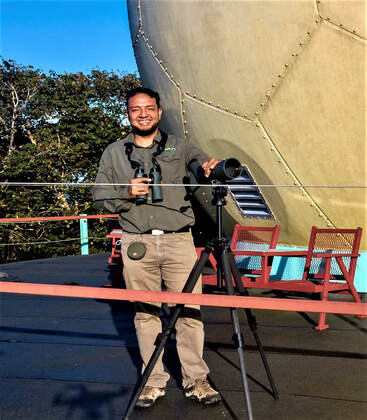
Birding Panama's Hotspots!
Presenter: Carlos Bethancourt
Blessed with incredible natural beauty and biodiversity, Panama boasts over 1,000 bird species, hundreds of mammals, reptiles & amphibians, and a staggering number of butterflies, dragonflies, beetles and plant species. Carlos will take us on a photographic journey of the tropical birds, bizarre mammals, unusual reptiles & amphibians and spectacular habitats from the Canal Zone, into the foothills of western Panama, and then on to the wilds of the Darién in eastern Panama - all the favorite hotspots. From toucans to hummingbirds, mouse opossums to tongue-wielding Orange Nectar Bats, Carlos will keep you spellbound with his stories of discovery and vivid images. Panama is indeed the country of amazing natural history and a favorite destination for birders who want to explore some of Central America's famous hotspots.
Presenter: Carlos Bethancourt
Blessed with incredible natural beauty and biodiversity, Panama boasts over 1,000 bird species, hundreds of mammals, reptiles & amphibians, and a staggering number of butterflies, dragonflies, beetles and plant species. Carlos will take us on a photographic journey of the tropical birds, bizarre mammals, unusual reptiles & amphibians and spectacular habitats from the Canal Zone, into the foothills of western Panama, and then on to the wilds of the Darién in eastern Panama - all the favorite hotspots. From toucans to hummingbirds, mouse opossums to tongue-wielding Orange Nectar Bats, Carlos will keep you spellbound with his stories of discovery and vivid images. Panama is indeed the country of amazing natural history and a favorite destination for birders who want to explore some of Central America's famous hotspots.
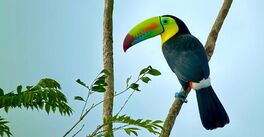
Carlos Bethancourt, who joined us from Panama, is Lead Guide and Marketing Manager for Canopy Family, an ecotourism business in Panama. Carlos has been guiding birders, including a few members of the Kirtland Bird Club, to many areas of Panama since 2000. See more about Canopy Family and Panama's treasures at www.canopytower.com
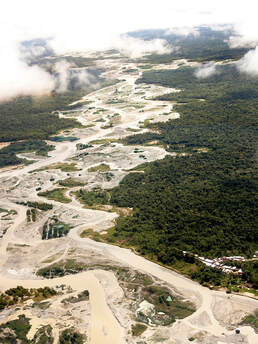
Wednesday, October 7, 2020
How a Cleveland Birder-Photographer Works on Conservation Efforts
in Colombia
Presenter: Steve Cagan
Steve Cagan is a birder and photographer who has been traveling to El Chocó, a Pacific rainforest area in Colombia, since 2003. The area faces threats to its rich rainforest and its human cultures. The threats come from mechanized gold mining, indiscriminate logging and industrial agricultural projects. In this region marked also by violence of the civil war and the displacement and death that have been visited upon the communities, Steve works with communities and organizations.
Despite the long odds against them, people in the communities have worked to save their environment, and with the help of committed NGOs, they have won some impressive victories. Steve will share images of some of the birds he has enjoyed seeing in the area and then share some of the ways he has been able to contribute to the efforts to resist and overcome those environmental and social threats.
Steve will also describe an error that a bird conservation organization in Colombia made in their relationship with local communities - from which we might draw lessons for our own work. The talk will end with a look at the recently published e-book about the issues around mechanized gold mining.
How a Cleveland Birder-Photographer Works on Conservation Efforts
in Colombia
Presenter: Steve Cagan
Steve Cagan is a birder and photographer who has been traveling to El Chocó, a Pacific rainforest area in Colombia, since 2003. The area faces threats to its rich rainforest and its human cultures. The threats come from mechanized gold mining, indiscriminate logging and industrial agricultural projects. In this region marked also by violence of the civil war and the displacement and death that have been visited upon the communities, Steve works with communities and organizations.
Despite the long odds against them, people in the communities have worked to save their environment, and with the help of committed NGOs, they have won some impressive victories. Steve will share images of some of the birds he has enjoyed seeing in the area and then share some of the ways he has been able to contribute to the efforts to resist and overcome those environmental and social threats.
Steve will also describe an error that a bird conservation organization in Colombia made in their relationship with local communities - from which we might draw lessons for our own work. The talk will end with a look at the recently published e-book about the issues around mechanized gold mining.
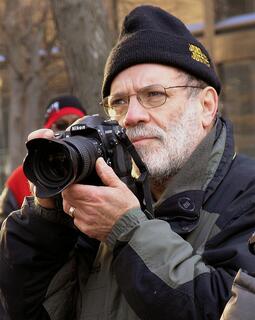
Steve calls himself a birder and photographer—not a bird photographer. Though he does take pictures of birds, his major work is related to social issues and community responses to those issues. He has exhibited and published photography on four continents. He has published reviews and critical writings in a variety of professional journals and books. Major awards include two Fulbright Fellowships, a National Endowment for the Arts Fellowship, and several Ohio and New Jersey Arts Council Fellowships. Steve taught at Mason Gross School of the Arts, Rutgers University, 1985-1993.
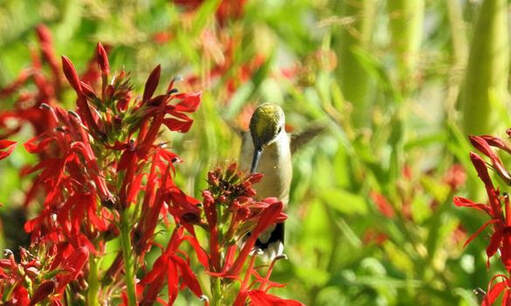
Wednesday, September 2, 2020
A NEW PRIMER
ON BACKYARD BIRD FEEDING
Presenter: John Barber
Video recording available here
How can we best feed birds in our yards? The accepted wisdom of many feeders brimming with commercially-grown seeds is increasingly seen as one of the lowest priorities for helping both nesting and migrating birds. Are we supporting birds that are relentless predators on open-cup nesting species? The answer lies in designing and planting a wide array of native trees, shrubs, and perennials to host the widest possible array of native insects, while avoiding the temptation to plant non-native and potentially invasive plants sometimes sold as "bird-friendly". Recent research suggests the highest probably of success for nesting Black-capped Chickadees results from yards planted with more than 70% native plants. We'll talk about turning yards of any size into truly bird-friendly habitats. >>More info is available here!
A NEW PRIMER
ON BACKYARD BIRD FEEDING
Presenter: John Barber
Video recording available here
How can we best feed birds in our yards? The accepted wisdom of many feeders brimming with commercially-grown seeds is increasingly seen as one of the lowest priorities for helping both nesting and migrating birds. Are we supporting birds that are relentless predators on open-cup nesting species? The answer lies in designing and planting a wide array of native trees, shrubs, and perennials to host the widest possible array of native insects, while avoiding the temptation to plant non-native and potentially invasive plants sometimes sold as "bird-friendly". Recent research suggests the highest probably of success for nesting Black-capped Chickadees results from yards planted with more than 70% native plants. We'll talk about turning yards of any size into truly bird-friendly habitats. >>More info is available here!
|
John has been a citizen scientist for over fifty years, active in green space preservation, the recovery of Peregrine Falcon populations, and the continuing recovery of Eastern Bluebirds. Now retired after 35 years in the business world, he is focused on restoring and maintaining biodiversity. He continues studies on bluebirds and performs habitat restoration and ecological gardening with native plants.
A native of Shaker Heights, he served on the board of the Nature Center for ten years, including two terms as Board President. He now serves on the board of the Native Plant Trust. He is co-leading the Friends of Lower Lake, a program of the Doan Brook Watershed Partnership, working to restore habitat around Lower Lake Park in the Shaker Parklands. |
Wednesday, August 5, 2020 - no recording available
|
A BIG YEAR,
LESSONS LEARNED Presenter: Joe Blanda, MD Dr. Joe Blanda, an orthopedic surgeon, shared his experience doing a Big Year, including the lessons he learned. A Big Year is a term used in the Birding Community to describe an endeavor to record as many birds as possible in a given year. Typically it involves lots of travel and endurance. Joe used his Big Year to raise money for cancer research - and he learned about more than just birds. He experienced the healing power of nature. His passion for the environment blossomed. He shared steps we all can take to help save the earth and share the healing power of nature as he does |
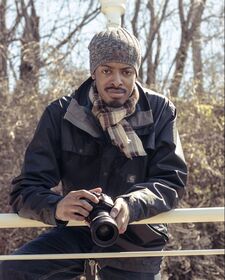
Wednesday, July 1, 2020 - video recording available here
Nature Cinematography: Kestrels in the Hood
Presenter: Najada Davis
Local filmmaker, Najada Davis, dazzled us as he recounted his experience filming wildlife. Najada grew up exploring local parks in Cleveland. During his time at Lakeland Community College, he started exploring video as a career choice and later turned towards film as a way to continue his outdoor adventures. His most recent adventure was right here in Cleveland with the Ohio City falcons. He shared tips to document wildlife yourself.
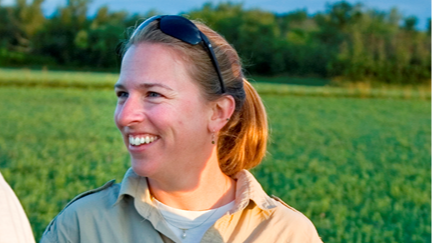
Wednesday, June 3, 2020
The Trumpet in the Orchestra of Evolution: The Story of the Sandhill
Crane in North America
Presenter: Anne Lacy
Video recording available here
Sandhill cranes are the most numerous of the world’s fifteen crane species. They inhabit many varied places in North America – and Asia! – in both migratory and non-migratory populations. Join us for a talk that will follow this species from tropical forests to arctic tundra, and the places they go in between.
Anne is a research associate in the Field Ecology Department (now the North America Program) of the International Crane Foundation. She works on an ongoing long-term study of Sandhill Cranes. She also works with the Whooping Crane Eastern Partnership to study the ecology of the newly reintroduced Whooping Cranes in Wisconsin.
The Trumpet in the Orchestra of Evolution: The Story of the Sandhill
Crane in North America
Presenter: Anne Lacy
Video recording available here
Sandhill cranes are the most numerous of the world’s fifteen crane species. They inhabit many varied places in North America – and Asia! – in both migratory and non-migratory populations. Join us for a talk that will follow this species from tropical forests to arctic tundra, and the places they go in between.
Anne is a research associate in the Field Ecology Department (now the North America Program) of the International Crane Foundation. She works on an ongoing long-term study of Sandhill Cranes. She also works with the Whooping Crane Eastern Partnership to study the ecology of the newly reintroduced Whooping Cranes in Wisconsin.
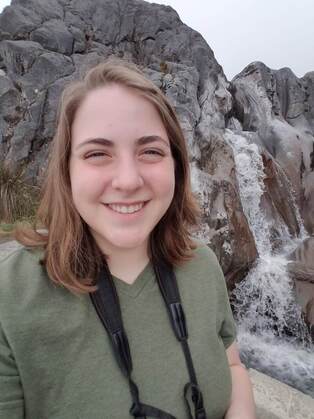
Wednesday, May 6, 2020
Eavesdropping on Birds: Automated Acoustic Surveys for Conservation
Presenter: Tessa Rhinehart
Global wildlife populations have declined 58% in the past 50 years. Currently, scientists study these declines using human-conducted biodiversity surveys. But the time commitment and expert knowledge required to undertake these surveys limit their scale, making them insufficient for addressing urgent, global problems. To address this gap in data collection, the Kitzes Lab at the University of Pittsburgh is developing automated methods of surveying sound-producing animals such as birds, frogs, wolves, and insects. These methods combine inexpensive autonomous recorders with artificial intelligence capable of identifying bird sounds. In this presentation, we will discuss the "why" and "how" of automated acoustic surveys.
Tessa Rhinehart is a scientist developing methods to study birds and other sound-producing animals at large scales. As a Research Programmer at the University of Pittsburgh, she uses computer programming and statistics to recognize animal sounds, collect population data, and understand and conserve ecosystems. Tessa is a native of Bradford, Pennsylvania and graduated from Swarthmore College with a dual degree in Mathematics and Biology. Outside of work, she is an avid birder and enjoys painting and drawing what she encounters in nature.
Eavesdropping on Birds: Automated Acoustic Surveys for Conservation
Presenter: Tessa Rhinehart
Global wildlife populations have declined 58% in the past 50 years. Currently, scientists study these declines using human-conducted biodiversity surveys. But the time commitment and expert knowledge required to undertake these surveys limit their scale, making them insufficient for addressing urgent, global problems. To address this gap in data collection, the Kitzes Lab at the University of Pittsburgh is developing automated methods of surveying sound-producing animals such as birds, frogs, wolves, and insects. These methods combine inexpensive autonomous recorders with artificial intelligence capable of identifying bird sounds. In this presentation, we will discuss the "why" and "how" of automated acoustic surveys.
Tessa Rhinehart is a scientist developing methods to study birds and other sound-producing animals at large scales. As a Research Programmer at the University of Pittsburgh, she uses computer programming and statistics to recognize animal sounds, collect population data, and understand and conserve ecosystems. Tessa is a native of Bradford, Pennsylvania and graduated from Swarthmore College with a dual degree in Mathematics and Biology. Outside of work, she is an avid birder and enjoys painting and drawing what she encounters in nature.
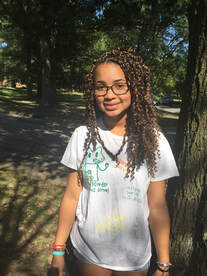
Wednesday, April 1, 2020
My experience in Birding Camp Colorado
Presenter: Helena Souffrant
Helena Souffrant, a junior at Western Reserve Academy, has been interested in all things nature for many years. She is a member of the Earth Initiative Club at her school and a member of the Ohio Young Birders Club. In addition to birding, Helena enjoys hiking, kayaking and playing the hammered and mountain dulcimers.
In 2019 Helena was the recipient of a Kirtland Bird Club scholarship to attend the American Birding Association's Camp Colorado, the subject of her presentation.
My experience in Birding Camp Colorado
Presenter: Helena Souffrant
Helena Souffrant, a junior at Western Reserve Academy, has been interested in all things nature for many years. She is a member of the Earth Initiative Club at her school and a member of the Ohio Young Birders Club. In addition to birding, Helena enjoys hiking, kayaking and playing the hammered and mountain dulcimers.
In 2019 Helena was the recipient of a Kirtland Bird Club scholarship to attend the American Birding Association's Camp Colorado, the subject of her presentation.
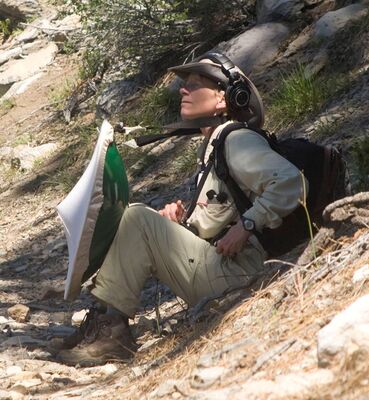
Wednesday, March 4, 2020
Five Years of Systematic Surveys
at Cleveland Lakefront Nature Preserve
Presenter: Laura Gooch
A group of dedicated volunteers have been performing systematic bird surveys at Cleveland Lakefront Nature Preserve (CLNP) several times each week since July of 2014. With over five years of data collected, we will make some observations about the survey effort to date, present some preliminary results, and discuss how the surveys fit into broader efforts to monitor bird populations.
Laura Gooch is a civil engineer by training and an ornithologist by avocation. After practicing environmental engineering for more than 15 years, she began photographing and observing birds. She is currently a research associate with the ornithology department of the Cleveland Museum of Natural History and a licensed bird bander affiliated with the Black Swamp Bird Observatory. Her bird-related work includes bird photography and song recording, bird banding, migration monitoring through night-flight call analysis, bird study skin preparation, breeding bird surveys, and coordination of systematic bird surveys at Cleveland Lakefront Nature Preserve.
Five Years of Systematic Surveys
at Cleveland Lakefront Nature Preserve
Presenter: Laura Gooch
A group of dedicated volunteers have been performing systematic bird surveys at Cleveland Lakefront Nature Preserve (CLNP) several times each week since July of 2014. With over five years of data collected, we will make some observations about the survey effort to date, present some preliminary results, and discuss how the surveys fit into broader efforts to monitor bird populations.
Laura Gooch is a civil engineer by training and an ornithologist by avocation. After practicing environmental engineering for more than 15 years, she began photographing and observing birds. She is currently a research associate with the ornithology department of the Cleveland Museum of Natural History and a licensed bird bander affiliated with the Black Swamp Bird Observatory. Her bird-related work includes bird photography and song recording, bird banding, migration monitoring through night-flight call analysis, bird study skin preparation, breeding bird surveys, and coordination of systematic bird surveys at Cleveland Lakefront Nature Preserve.
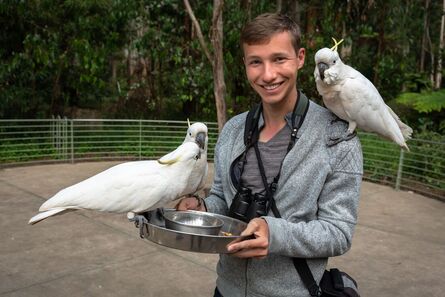
Wednesday, February 5, 2020
The End of the Rainbow came to me
Lukas’ Adventures in Micronesia!
Presenter: Lukas Padegimas
Join Lukas Padegimas for an evening filled with his tales of adventure on the remote islands of Micronesia, a region of thousands
of remarkable islands stretching across the tropical Pacific Ocean. These islands are home to vibrant cultures with peculiarities found nowhere else on the planet, endemic birds whose ranges sometimes extend no further than a single mountain peak, and pristine coral reefs. Lukas will share some of his best misadventures and the lessons learned while on his quest to experience everything the islands have to offer. You, too, will learn why Lukas believes it is one of those places on earth where childhood dreams come true!
Lukas’ adventures began when he decided to join a FWS expedition to the Alaskan Arctic to study shorebirds in lieu of attending his high school graduation. Since then, Lukas has visited over 20 countries, published two books about his travels, and aimed to make the best of every day of his life. For the last two years, Lukas has lived on Chuuk in the Federated States of Micronesia and served as the Court Attorney for the Chuuk State Supreme Court. In his spare time, Lukas snorkeled the surrounding reefs, dove many of the 60+ shipwrecks found in the Chuuk Lagoon, organized trips to rarely accessible places, and composed music. In addition, he traveled throughout Micronesia to learn as much as possible about the customs and traditions of the surrounding island groups and, of course, birded along the way.
The End of the Rainbow came to me
Lukas’ Adventures in Micronesia!
Presenter: Lukas Padegimas
Join Lukas Padegimas for an evening filled with his tales of adventure on the remote islands of Micronesia, a region of thousands
of remarkable islands stretching across the tropical Pacific Ocean. These islands are home to vibrant cultures with peculiarities found nowhere else on the planet, endemic birds whose ranges sometimes extend no further than a single mountain peak, and pristine coral reefs. Lukas will share some of his best misadventures and the lessons learned while on his quest to experience everything the islands have to offer. You, too, will learn why Lukas believes it is one of those places on earth where childhood dreams come true!
Lukas’ adventures began when he decided to join a FWS expedition to the Alaskan Arctic to study shorebirds in lieu of attending his high school graduation. Since then, Lukas has visited over 20 countries, published two books about his travels, and aimed to make the best of every day of his life. For the last two years, Lukas has lived on Chuuk in the Federated States of Micronesia and served as the Court Attorney for the Chuuk State Supreme Court. In his spare time, Lukas snorkeled the surrounding reefs, dove many of the 60+ shipwrecks found in the Chuuk Lagoon, organized trips to rarely accessible places, and composed music. In addition, he traveled throughout Micronesia to learn as much as possible about the customs and traditions of the surrounding island groups and, of course, birded along the way.
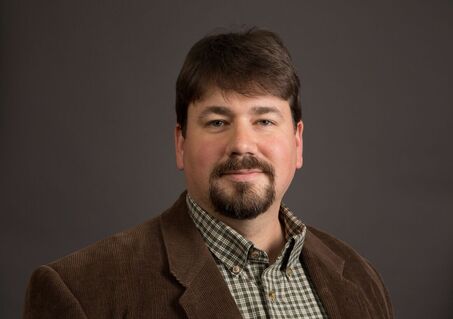
Wednesday, January 8, 2020
Ornithology Discoveries in 2019
Presenter: Dr. Andy Jones
Dr. Andy Jones returns for his annual talk to the Kirtland Bird Club to highlight the recent exciting findings from the world of ornithology. There are thousands of academic papers published every year on the biology of birds. These new discoveries are sometimes highlighted in newspapers, magazines, and on your Facebook feed, but far too many simply don't get the public attention that they deserve. Dr. Jones will highlight the taxonomic changes that birders will want to know about, as well as other discoveries that will simply make you a more observant and more informed birder. This talk will cover many exciting aspects of bird biology that were discovered in the last two years.
Dr. Jones received his BS in Biological Sciences from the University of Tennessee at Knoxville, and his PhD in Ecology, Evolution, and Behavior from the University of Minnesota. He originally hails from east Tennessee, where his passion for natural history began at an early age; his current research involves the evolutionary history of birds from the Appalachian mountains as well as the Andes and the Philippines. Dr. Jones is responsible for the Museum’s collection of avian specimens, which consists of approximately 30,000 study skins and 4,000 egg sets from the Ohio region and western North America as well as approximately 1,000 osteological specimens from Ohio. He is also responsible for specimen acquisition and preservation, maintenance of specimen records, and carrying out original research. His other tasks include providing various services to the scientific community, the media, the Museum’s exhibitions and education divisions as well as the public at large. Dr. Jones was among 14 prominent American ornithologists to be named an elective member of the American Ornithologists' Union (AOU) in 2009, and in 2014 he was elected as Secretary of the AOU.
Ornithology Discoveries in 2019
Presenter: Dr. Andy Jones
Dr. Andy Jones returns for his annual talk to the Kirtland Bird Club to highlight the recent exciting findings from the world of ornithology. There are thousands of academic papers published every year on the biology of birds. These new discoveries are sometimes highlighted in newspapers, magazines, and on your Facebook feed, but far too many simply don't get the public attention that they deserve. Dr. Jones will highlight the taxonomic changes that birders will want to know about, as well as other discoveries that will simply make you a more observant and more informed birder. This talk will cover many exciting aspects of bird biology that were discovered in the last two years.
Dr. Jones received his BS in Biological Sciences from the University of Tennessee at Knoxville, and his PhD in Ecology, Evolution, and Behavior from the University of Minnesota. He originally hails from east Tennessee, where his passion for natural history began at an early age; his current research involves the evolutionary history of birds from the Appalachian mountains as well as the Andes and the Philippines. Dr. Jones is responsible for the Museum’s collection of avian specimens, which consists of approximately 30,000 study skins and 4,000 egg sets from the Ohio region and western North America as well as approximately 1,000 osteological specimens from Ohio. He is also responsible for specimen acquisition and preservation, maintenance of specimen records, and carrying out original research. His other tasks include providing various services to the scientific community, the media, the Museum’s exhibitions and education divisions as well as the public at large. Dr. Jones was among 14 prominent American ornithologists to be named an elective member of the American Ornithologists' Union (AOU) in 2009, and in 2014 he was elected as Secretary of the AOU.
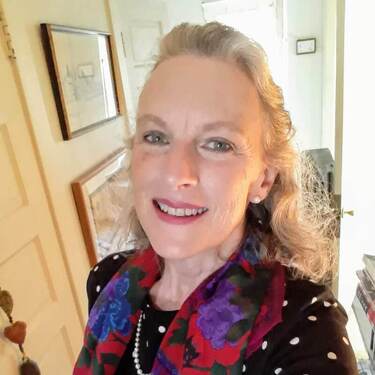
Wednesday, December 4, 2019
Urban Birding Cleveland:
Connecting to the Nature Around Us
Presenter: Betsey O’Hagan
Betsey O'Hagan guided us through a pictorial retrospect of the recent 'Urban Birding with David Lindo' activities November 2-9, 2019. A variety of activities that week introduced Mr. Lindo to our region's finest citizen scientists, birders, and conservation-minded public. Participants explored iconic natural areas in the Lake Erie Basin, engaged with next generation birders, and investigated issues and restorative solutions to address the future challenges of wildlife, habitat, and people co-existing in changing urban landscapes.
Betsey is as an innovative digital design architect and collaborative leader for transformational change. She dedicates her time to helping conservation organizations leverage the power of the Internet for business operations, entrepreneurial enterprise, and citizen science communications for future generations.
Urban Birding Cleveland:
Connecting to the Nature Around Us
Presenter: Betsey O’Hagan
Betsey O'Hagan guided us through a pictorial retrospect of the recent 'Urban Birding with David Lindo' activities November 2-9, 2019. A variety of activities that week introduced Mr. Lindo to our region's finest citizen scientists, birders, and conservation-minded public. Participants explored iconic natural areas in the Lake Erie Basin, engaged with next generation birders, and investigated issues and restorative solutions to address the future challenges of wildlife, habitat, and people co-existing in changing urban landscapes.
Betsey is as an innovative digital design architect and collaborative leader for transformational change. She dedicates her time to helping conservation organizations leverage the power of the Internet for business operations, entrepreneurial enterprise, and citizen science communications for future generations.
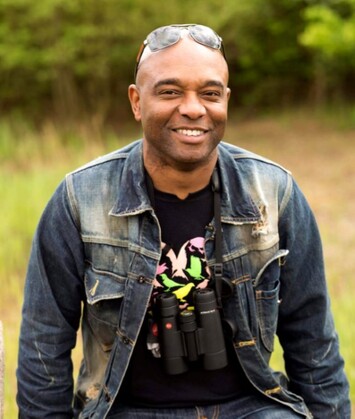
Wednesday, November 6, 2019
Urban Birding
Presenter: David Lindo
David Lindo, A British citizen, is Vice-President of the Wildfowl & Wetlands Trust and was voted the seventh most influential person in Wildlife by BBC Wildlife Magazine. He is a Member of the British Guild of Travel Writers and a Fellow of the International League of Conservation Writers, Proud Ambassador for Leica Birding, London Wildlife Trust, Rare Bird Alert, EcoNoja Feria Internacional and the Colombia Bird Fair, President of The Friends of Suntrap Forest Education Centre, and author of several books including the recently published, How to Be an Urban Birder. David will present on his urban birding experiences around the world in an effort to raise awareness and educate people on the importance of preservation and conservation of bird and wildlife habitat.
Visit the Urban Birder website: https://theurbanbirder.com
David Lindo’s visit to northeast Ohio celebrated the launch of Urban Birding Cleveland, a Western Cuyahoga Audubon Society initiative for local birders of all ages. The week was filled with opportunities for the public to join David and Cleveland’s expert bird walk leaders, birders, and dedicated citizen scientists on a series of urban bird walks and field trips that showcased northeast Ohio’s iconic green spaces and birding locations in Cleveland and the surrounding Emerald Necklace.
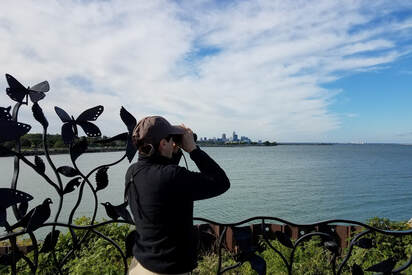
Wednesday, September 4, 2019
Kirtland Bird Club field trip and dinner
Cleveland Lakefront Nature Preserve
Members and guests wereinvited to attend a field trip to Cleveland Lakefront Nature Preserve instead of meeting at the Cleveland Museum of Natural History. After the walk we met at Muldoon's Saloon & Eatery to eat and have an informal discussion about the club's future.
